Arturia MatrixBrute – a fabulous instrument. This synthesizer, available since the beginning of 2017, will some day count among one of the REALLY BIG instruments of the new century. A TOP synth. Assuming, of course, that SMD technology and „Made in China“ are no big obstacles.
At the moment, we find no such detriments to its quality. In fact: After presentation of the prototype in 2016, Arturia even did a little additional pepping up … now the synth has gorgeous aluminium wheels instead of those original plastic wheels. And since its first major software update (mid 2017), the MatrixBrute is about as perfect as you could even wish.
„Perfect“ is not a helpful definition, of course. Perfect is in the eye of the beholder, so to speak. It’s like this: you sit down at an instrument and you want to – SURPRISE – make music! You don’t want look around for functions (you want to find them), you don’t want to have critical thoughts about the hardware, you don’t wanna end up in a musical dead-end shortly before you reached your goal. And nobody wants to have to leaf through some substandard user manual … one just wants to sit down and make MUSIC.
It’s as simple as that!
This is a report on just such a happy experience. Our partner is the MatrixBrute. Unpack it, set it up, plug it in. Sit down and work your way from one end of the synth to the other. Two glances at the little (but well-written) user’s manual – and off you go.
Here at the left you can adjust the oscillator beats, the knob down there is for osc synchronization. Direct recording of sequences via the keybord? – no problem. Replaying patterns via START? Transposing patterns via HOLD? Modulation routings easily done via the fabulous matrix (16×16 rubber switches)? Direct access to filter frequency via the aluminum wheel? It’s all there. EVERY attempted change in sound and performance suceeds on the first try. Even speed-modulation of the two LFOs is absolutely no problem (e.g. by the extra ENV 3, a short glance in the manual makes it possible). Grand MatrixBrute.
We have to admit: The above approach is not really to be emulated. The manufacturer specifically asks for concious study of the manual before turning on the instrument. We nod guiltily and promise to better our ways. Perhaps we can make amends by proposing that this „MatrixBrute-Kick-Off-Test“ works just as well: Sit down and make music. Mission possible!
256 Presets – The Power Of The Matrix
Everything about the MatrixBrute is spectacular. So let’s begin with the GIVENS. And what these mean in reality.
The MatrixBrute sports 256 presets. We tend to think that this is peanuts. In times like these, when many instruments offer thousands of sounds (something that could be more frightening than reassuring, let’s be honest), 256 presets doesn’t sound like much. This is where the matrix comes in. It makes apperent, how „many“ sounds 256 sounds really are.
Let’s assume that we’re not talking about just any sounds, but in fact about really good sounds. About sounds that require a lot of time to create. Something which, in case of the MatrixBrute, should be self-evident. All those sound-parameters, all those modulation possibilities, here the sequencer (and the arpeggiator), there the analog effect section, then further extras … all a question of time and effort. Which means, programming a good sound (including powerful performance adjustments) is not a question of a few minutes, but rather of one or two hours.
Now, let’s imagine you create ONE sound every day of the week. You rush in from work, sit down at your MatrixBrute, and off you go. You have weekends and holidays off (of course), where you can play and enjoy your sounds without a guilty concious (or spend some time with your family, whatever …). But aside from this, you create new MatrixBrute sounds from Monday to Friday, one per day.
If you’re rigorous about this, filling the synthesizer with your own sounds should take you ONE YEAR, plus – depending on holidays and where you live – up to an additional 6 days (or so).
One year’s work for 256 sounds. Impressive.
After this little divergence into the joys of programming, we finally arrive at even more impressive details about the instrument. Let’s begin with the …
Basic Features
- Analog subtractive Synthesizer
- 3 voice modes: monophonic, paraphonic, Duo-Split mode
- 256 presets and 256 memories for sequences x
- 2 main VCOs + 2 sub-oscillators
- 1 extra VCO/LFO
- noise generator (white/pink/red/blue noise)
- 5-channel mixer (incl. Audio-In)
- Steiner-Parker VCF
- Moog-Ladder VCF
- 2 main LFOs
- 3 envelopes
- keyboard with 4 octaves (49 keys – luxury!)
- modulation matrix (16×16 buttons)
- 64-step sequencer
- arpeggiator
- analog effect section
- 2 aluminium wheels (mod-wheel assignable to any destination)
- 4 macro-controller (also freely assignable)
- comprehensive CV/Gate patchbay
- MIDI, USB, Sync (In/Out)
x - Size: 86 x 43,2 x 10,7 cm (closed panel)
- Weight: 20 kg
Considering ALL of it is impressive, what would be a real MatrixBrute highlight? 3 VCOs and 3 LFOs (if using VCO3 in low frequ mode), for example. As are 3 envelopes. And: each of the 5 audio sources can be individually routed to the Steiner- and/or the Moog-VCF. Both VCFs can work parallel and/or in series. There are four (!) types of noise are available (white, pink, red and blue).
The pitchbend-area is programmable up to one octave. The Mod Wheel can control every parameter of the MatrixBrute (via the modulation matrix assignment). The entire synth can be turned into an independent 2-voice package, with a programmable split point. Example: The left side of the keyboard runs a sequence, while the right side of the keyboard can be used for lead sounds – duo-timbre in real-time!
Nearly no wish goes unfullfilled regarding the sound architecture. In fact, the player – confronted with a huge mass of possibilities – may find himself yearning for the simple Arturia MiniBrute and MicroBrute of earlier days.
But now to the quintessence:
The MatrixBrute Concept
A quick look at the team that assisted in bringing the MatrixBrute to life may help us to grasp the magic behind the instrument.
Such a huge array of designers and developers – so much man-power and brain-power – evoces a notion of what went into the development of this synth. It’s immediately evident to the user: Every aspect of the instrument – hardware or software – is perfectly in place and intuitively arranged. The combination of well-located functions, user-friendly surfaces and (behind the scenes) powerful software is one of the special aspects of the MatrixBrute. Which brings that „mass of possibilities“ full circle: Even the logic behind the use of the instrument is extremely functional.*
[* … as to the pictures: we personally optimized our MatrixBrute by adding some white knobs. That makes the VCO-waveforms and the VCF-frequencies easier to recognize among all the other knobs.]
BIG Advantages
– Three Versatile VCOs
Well-known and generally highly appreciated: the versatile Arturia VCO. MatrixBrute has two of them, as well as an extra (3rd) VCO / LFO. Each of the main oscillators sports impressive goodies that you might know from the MiniBrute / MicroBrute (mixable waveforms; ultrasaw-, PWM-, metalizer-option). There are also 2 strong sub-oscillators (sine or pulse wave), for those deep low-ends in sound. Heaps of knobs to help you find just the right timbre.
Finally, the mixer section allows for the adjustment of volume- and filter-routing for the 3 VCOs, together with EXT (IN) and NOISE. 5 audio signals, so to speak.
– Special Extra: Audio Modulation
A great subtlety offered to the in-depth sound-designer: the AUDIO MOD corner. VCO1 can modulate the pitch of VCO2 (frequency modulation – FM). VCO3 can be used for FM, too, modulating either of the two main VCOs and either of the two VCFs. Finally, there’s noise-modulation (for VCO1 or VCF1).
In the modulation matrix, each AUDIO MOD knob can be specified as a modulation source, so that – for example – velocity may control the amount of VCO3-to-VCF2-frequency modulation. Heavy stuff.
– Two Flexible VCFs
Steiner-Parker VCF: LP / BP / HP and Notch; 24dB / 12dB
Moog Ladder VCF: LP / BP / HP; 24dB / 12dB
The two multimode-filters can be used separately, in parallel or in series. Besides frequency, resonance, envelope amount and output volume, each VCF sports the famous BRUTE factor and DRIVE knob. Finally, a common (and very eye-catching) aluminium rotary wheel allows the simultaneous control of both filter frequencies. Superb!
Additional filter modulation via:
- the MatrixBrute Matrix
(16 mod sources, including VEL and AT) - velocity (part of the VCF envelope)
- the modulation wheel
- expression pedal
- CV-input
- MIDI
– Three (Extended) Envelopes
Well, both envelopes 1 and 2 are standard: ADSR. Each of them comes with a fifth slider (white top) that allows the simple (but effective) adjustment of envelope modulation via velocity. Separately adjustable for VCF and VCA. Very important for that bit of extra “organic timbre” in the sound.
Envelope no. 3 is slightly different. First, it is “not” pre-wired. Ok, ok, that’s not quite correct: it is pre-wired, but only in DUAL/SPLIT mode, then responsible for both VCF- and VCA-control of the second voice. But in regular MONO mode, it just sits there and does nothing. Nothing, until you finally get busy and do some modulation matrix programming. Route ENV 3 to, let’s say, speed of LFO1 and/or to VCO2 frequency, whatever. Envelope no. 3 has a delay control instead of velocity. Which makes sense, considering its primary purpose as a modulation source …
– Two (Three) Powerful LFOs
The two main LFOs are (nearly) identical. Each oft them offers 7 (!) waveforms. Synchronizing LFO-speed with the sequencer is a simply matter with the push of a button. (Incidentally, note should be taken of the fabulous MatrixBrute synchronization features: ALL time-based elements – even the analog delay – can be coordinated. Superb.)
LFO re-triggering can be set to OFF (standard, we guess), SINGLE or MULTIPLE key trigger. LFO1 offers a knob for PHASE shifting, LFO2 has an extra DELAY control.
The range of the main LFOs is from “1 cycle per 18 seconds” (veeery slow *) up to “100 cycles per second” (100 Hz).
[* We can’t confirm the veeery slow LFO speed range. It seems to be clearly more than “1 cycle per 18 seconds”.]
The third LFO (alias VCO) is that powerful low/high-frequency oscillator we met in the AUDIO MOD section. It massively extends the sound spectrum of the MatrixBrute (“FM” and other experimental happinesses).
– Delicate Analog Effect Section
Excellent: (mono / stereo) delay, flanger, chorus, reverb. A simple, yet very user-friendly section with a few (decisive) controls. Contributes a lot of character (and a bit of warmth) to the overall MatrixBrute sound. Responsible for some unique music performances, especially in combination with the internal step-sequencer (call it “synchronization”).
And here’s the clou: each knob (Delay Time, Regeneration, etc.) can be assigned as a modulation destination in the Matrix. Just like (nearly) every knob of the instrument. Anyway, the possibility of voltage-controlling the analog effects has in particular its own particular charm …
– Matrix: One Panel – Three Jobs
The key feature of the instrument – it’s Matrix, so to say – is not only very elegant, but also very flexible. It is used to:
- recall / store 256 sounds / 256 sequences
- program the sequencer (and the arpeggiator)
- create a network of modulation links
Here’s the brilliant Matrix procedure. Voilà. Press PRESET and select sounds, press SEQ and create patterns, press MOD and set your modulations.
PRESET has already been considered on that philosophical note (“one year of work,” as you probably remember). The SEQuencer compartment contains a 64-step recorder with 4 tracks (note, accent, glide and mod(ulation)). Excellent.
Each of the 256 patterns can be connected to any sound simply by pressing LINK. The ARPeggiator is hidden somewhere in the SEQ area. And it can – you’ve probably guessed it – do more than plain arpeggiation. The “Matrix Arpeggio Mode” turns the Matrix into an clever arpeggiator programming tool, with separate rows for trigger and notes/octaves. A brilliant idea.
Finally, MOD is the genius brain behind the modulation busses. Arturia calls the Matrix an “electronic patchbay”, which puts it very well. As we said before, ANY knob (slider) of the MatrixBrute sound path and effect section can be set as a modulation destination. Please repeat, loud and clear: “every knob” … something even well-equipped modular synthesizers can only dream off …*
[* Ok, ok, this may be going off the deep-end of enthusiasm. The Eurorack modular market has erupted during the last years, and it could be that there’s absolutely no module, nothing you can think of that does not exist. Anyway, the MatrixBrute’s flexibility is imposing: control voltage of every part of the envelope, control voltage of the DRY/WET effect signal, dynamic control of LFO speed, of sub-oscillator volume, etc., etc. …]
– Extensive Performance Features
4 octaves with velocity and aftertouch give you enough potential for full-range soli (MONO mode), for playing chords (PARAPHONIC) and for performing two sounds simultaneously (DUAL-SPLIT). The transpose knob left of the keyboard (+/- 2 octaves) extends the total range to a serious 8 octaves. Not bad …
The two aluminum wheels (each with a little “A” – Arturia emblem on the inside) are a pleasure to use. The pitch wheel is – as we said before – programmable (up to one octave), as is the Mod wheel – assignable to the Matrix, the global VCF cut-off, LFO1 Vib(rato) or LFO1 Amount. Fiddling around with these wheels just tops things off.
In an “ideal” world, Arturia would have added a beautiful ribbon controller as well, tastefully integrated into the wood. But we have to be fair: Regarding the extremely fair price of the MatrixBrute, there’s no room for even more wishes.
Four macro controllers round off the performance section. Freely assignable, each knob can control up to 16 modulation destinations at once (matrix mod programming). Equally ingenious: the comprehensive CV/Gate connections and assignable pedal inputs. Great praise!
Then there’s the MIDI Control Center, actually a MatrixBrute “Total Control Station”, available for free download at the Arturia website. The software might also serve as an advertising platform of sorts, boosting useful monitoring-, control- and storage-possibilities for 18 Arturia instruments (to date).
Total Control Doesn’t Mean You Don’t Have To Listen
Chasing after all the little bites and bytes seems a bit finicky. Not just with the MatrixBrute. It’s a question of a musician’s personal attitude and work preferences. Almost as if spontaneous, unexpected things in the acoustical landscape could put a warp on one’s overall musical image. Be that as it may: those of you who need complete digital control will be pleased to see that it’s all there, one way or the other. All MatrixBrute knobs send MIDI CC data!
But the nice thing is that TOTAL CONTROL is neither prescribed nor necessary for your MatrixBrute workflow. That little display just indicates the preset name and the 4 macro controller assignments – above and beyond, it remains pleasingly uncommunicative. Because you don’t need more than that.
Wheather or not the velocity intensitiy is exactly right, whether the length of the decay tie is exact correct, whether or not the mixture of the VCO waveforms could be refined by this or that nuance – all of that is something your EARS are responsible for. Because listening to the sound and tweaking knobs in realtime remains the most intuitive (end effective!) method of playing analog synthesizers. Thank heavens for Arturia’s insight.
Meaning both worlds can be satisfied. On the one hand, the live keyboarder has his spontaneity (without being distracted by continualy changing information on the display, e.g. permanently varying menues). On the other hand the picky bits- and bytes-freak has total control via computer and MIDI CC, illuminating every tinyest corner of his acoustical material. Fantastic.
Magical Hardware
Quality and weight often go hand in hand in (musical) electronics. Old hat, but true just the same. The revelation begins with the unpacking. This MatrixBrute just has to be very good, weighing, as it does, 20 kilos! Beautiful, solid wood (fortunately real wood), a heavy metal chassis, solid knobs and switches, generous faders. The MatrixBrute makes you happy before you have even heard it (and after that all the more).
A beautiful instrument automatically commands great respect. While gingerly unlocking, lifting and adjusting the panel, carefully connecting the cables and thoughtfully slipping on the power switch, the eloquence and elegance of the MatrixBrute is irrestistable, impossible to ignore.
Which brings us to the one question we are not able to answer: Assuming respectful use, how durable is „Made in China“?
On the one hand, „Made in China“ these days implies a very high level of (hardware) quality. It‘s probably high time to get rid of some old prejudices.
On the other hand, we do know of some cases where the MiniBrute (loose keyboard metal plates) and the MicroBrute (constant tone signal, impossible to make it stop) have been known to wander off to the eternal hunting grounds after only 18 months.
And aaaahm … as it slowly becomes apparent since around 2020, the rubber pots of previous Arturia products become unpleasantly sticky after a few years – not necessarily, but in many cases. Very annoying, first because the sticky pots do not feel good at all (to put it politely), second, because the question of replacement does not seem to be discussed on the part of Arturia. One answer might be the MatrixBrute NOIR Edition, which comes with new hard-plastic knob caps.
Some Thoughts On Sound
First, a question: Considering the assets of the MatrixBrute, can’t we just throw a lot of those other instruments out there over board? In a way, yes.
But on the other hand, a (new) Minimoog is (and remains) a (new) Minimoog and a GRP A2 is (and remains) a GRP A2. Both of which are not obsolete. There are other examples, but these two instruments demonstrate the neccessitiy of spending some thoughts on the SOUND of Arturia’s latest flagship.
We have attached 40 minutes of soundfiles demonstrating (part of) the acoustical world of the MatrixBrute. The Arturia timbre – certainly we may call it that – is essentially a little bit on the clinical side. Full analog and very flexible, of course, but just the same: a little clinical.*
[* …“Arturia’s own modern touch and character” – this quote comes from the MatrixBrute user’s manual.]
So back to our objects of comparison. With 3 VCOs and a ladder, the MatrixBrute should get close to the Minimoog sound ..? Wrong there. And with 2 VCOs and the Steiner VCF (notch!) you should get close to the GRP A2 ..? No chance.
This is – to be on the positive side – good. Allthough the MatrixBrute is a magic box par excellence, it does not replace every other instrument. Its strengths are there where it is 1000 % right: flexibility and musical performance. Warmth, on the other hand, is not one of its strengths. Creamy oscillator-phasing and ultra-snappy envelopes are just somehow creamier and snappier with other instruments. In other words: The MatrixBrute is not an analog beast, it’s a synthesizer with a straightforward, modern analog sound.
So: flexibility and music performance – welcome to the MatrxiBrute. Heaps of solo sounds, effect sounds, bass and pad sounds (paraphon!) available. But that’s just not everything …
… the final touch is when you employ the sequencer (arpeggiator) and the genius modulation matrix. It’s at this point that the MatrixBrute mutates into a perpetuum mobile – a self-propelling musical machine with nearly endless possibilities. Then (and only then) does the MatrixBrute mutate to something unique. To something you become addicted to.
Now, the ultimate “crowning glory” is – in our opinion – the MatrixBrute’s analog effect section. Start the pulsating sequencer, add some (stereo!) delay, turn up the feedback-loop and listen to the MAGIC, to the aural excitement that surrounds you. It’s a world of its own.
In the wink of an eye, the MatrixBrute will be the heart of your studio: Self-sufficient, thanks to the sequencer-plus-analog-effect-package (… just take a seat, plug in your headphones and off you go); A centre of analog/digital communication, thanks to MIDI, USB and that vast cv/gate panel.* The musical results are astounding and – with or without „warmth“ – first-rate.
[* Although, to be truthful, we did have some difficulties with (analog) synchronization. E.g.: there was no way to run the MatrixBrute sequencer and the Korg Monotribe in parallel. It seemed as if the MatrixBrute Gate-Out signal was a little corrupt, resulting in a permanent „hiccup“ of the Monotribe drums. But as we have said, we expect the one or other MatrixBrute software update in the near future.]
Still, to be absolutely correct, there are three things that could be improved regarding to performance, signal path and audio quality:
First (performance): Switching from one sound to the other causes a short “dead point” – a split second, in which nothing happens (no sound). This minimally blocks the overall performance.
Second (signal path): Neither the two VCFs nor the two independent sounds (in dual mode) can be positioned in the stereo field. After all, you have 3 VCOs, 2 independent filters and, besides the VCA, an additional “hidden VCA” for the second voice. But adjusting panorama remains a sealed book. (The stereo feature is reserved exclusively for the analog effect section.)
Third (audio quality): The output signal of the MatrixBrute is a bit noisy. “A bit” means a bit more noise than a studio device should have. Performing the MatrixBrute LIVE you won’t be aware of the mediocre signal-to-noise-ratio, but in the studio (recording several MatrixBrute tracks and listening to the results carefully), the noisy audio is clearly audible.
To sum it all up
Who knows? Maybe the MatrixBrute will advance to the „synthesizer of the decade“. Its amazing concept enables it to do everything and to be everything. It’s as simple as that. Taking into account the philosophy behind the Matrix (256 presets = one year’s worth of daily sound design) and the above-discussed descriptions, it is an instrument par excellence.
Magic for just under 2,000 USD. A tour de force …
x
Update 07/2021. Arturia released the MatrixBute Noir Edition. Painting job and knobs (substituting the original, sticky rubber knobs) have changed, the rest is pure original MatrixBrute.
x
Attached: 50 minutes of MatrixBrute sound samples. 95% of what you hear is pure MatrixBrute. In one file (DEMO 1) the GRP A8 contributes a stereo sequence (for that extra “warmth of sound”), in another file (SOLO paraphon) an Indian drum computer (Electronic Tabla) adds, well, some Asian percussion flair. All other sounds are pure Arturia. All performances done directly on the MatrixBrute, with the use of the internal sequencer and those great internal effects, and – once or twice – an external reverb, the Quantec QRS. Enjoy.
Arturia MatrixBrute
Paraphonic Analog Synthesizer
with Mod Matrix / Sequencer
Website Manufacturer:
www.arturia.com
Open / Download:
MatrixBrute Photo (3400 x 2400 px)
Comparison / Links:
MatrixBrute Test Report by Gordon Reid (SoundOnSound)
Youtube Video by Olivier Briand

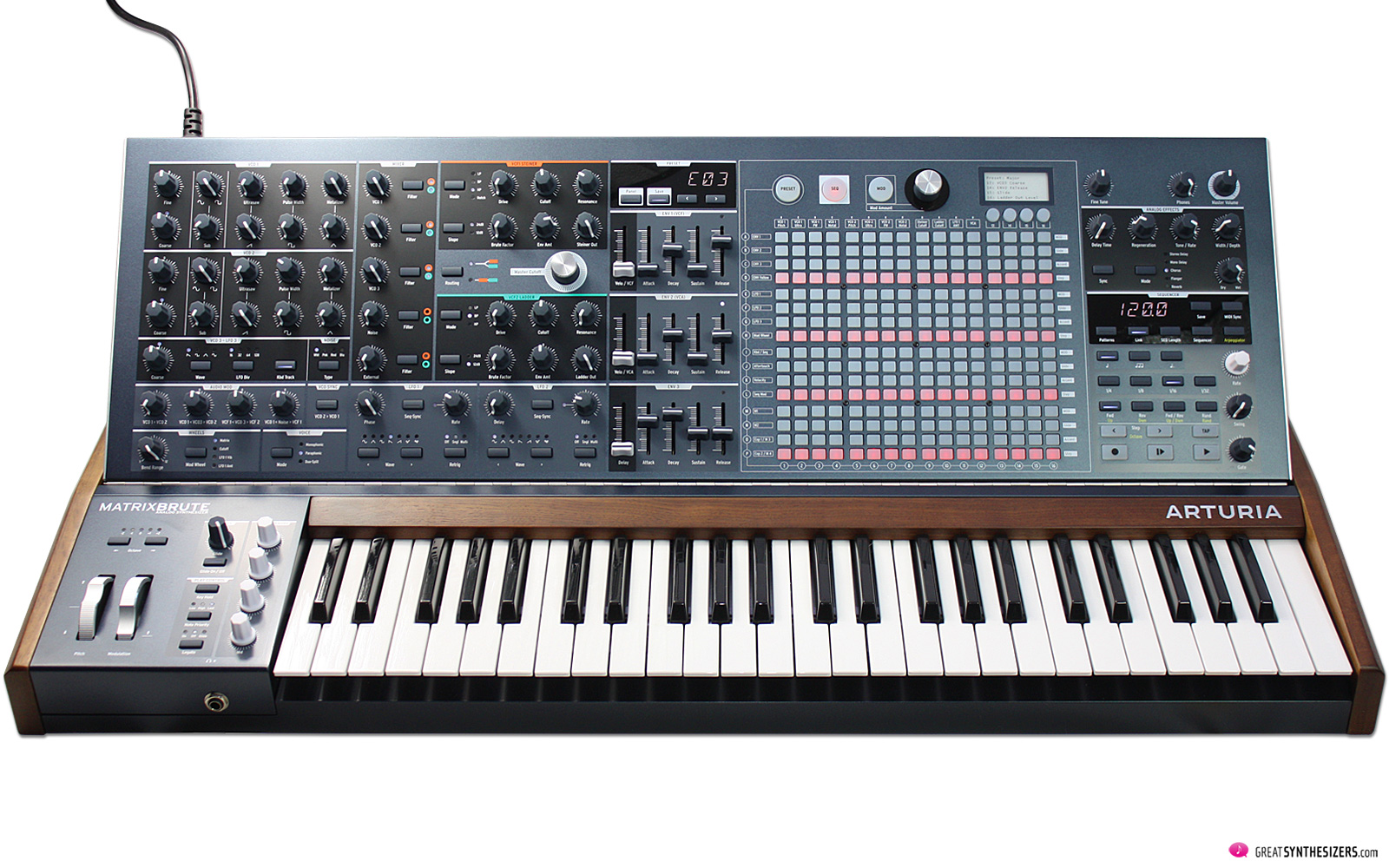

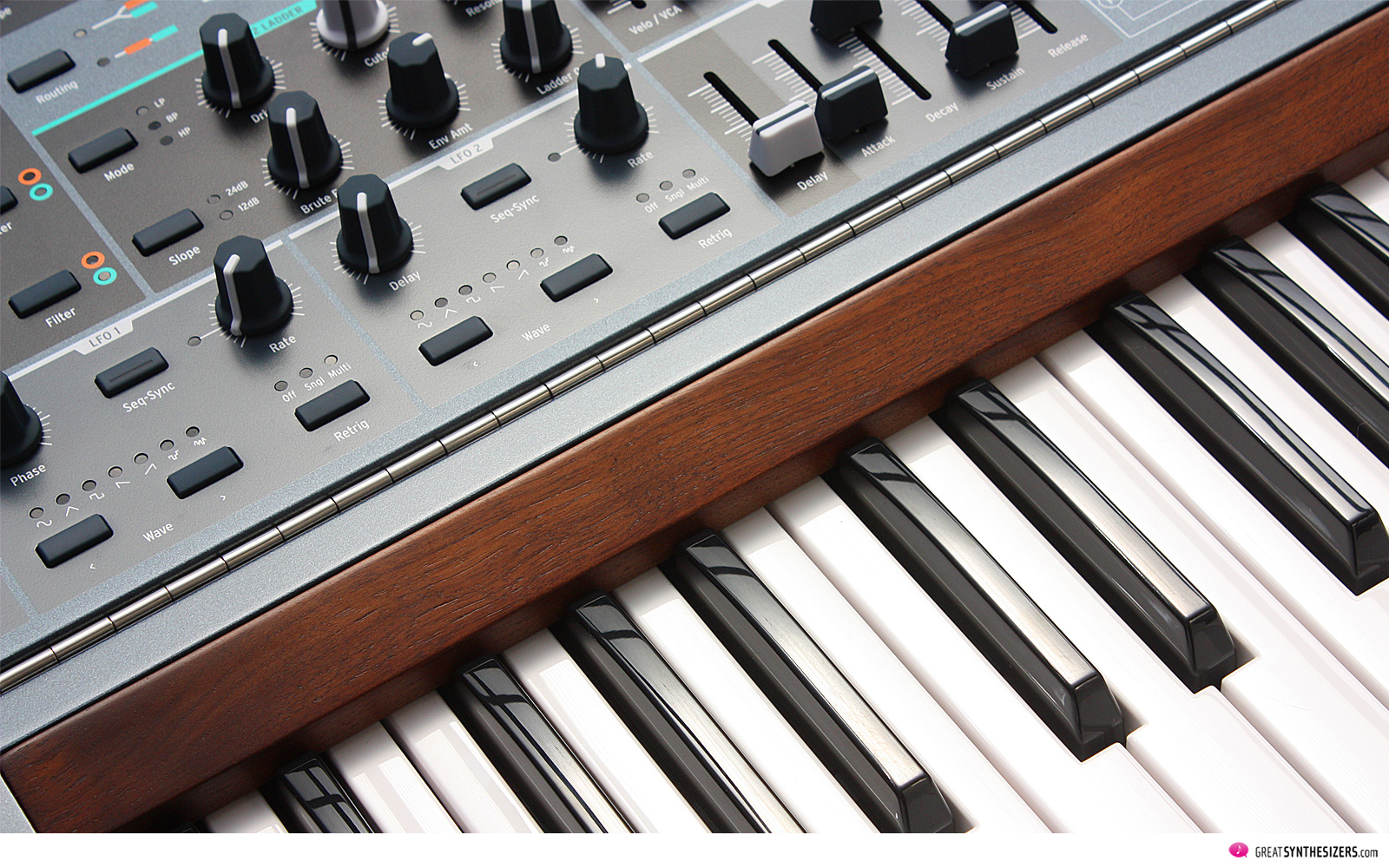
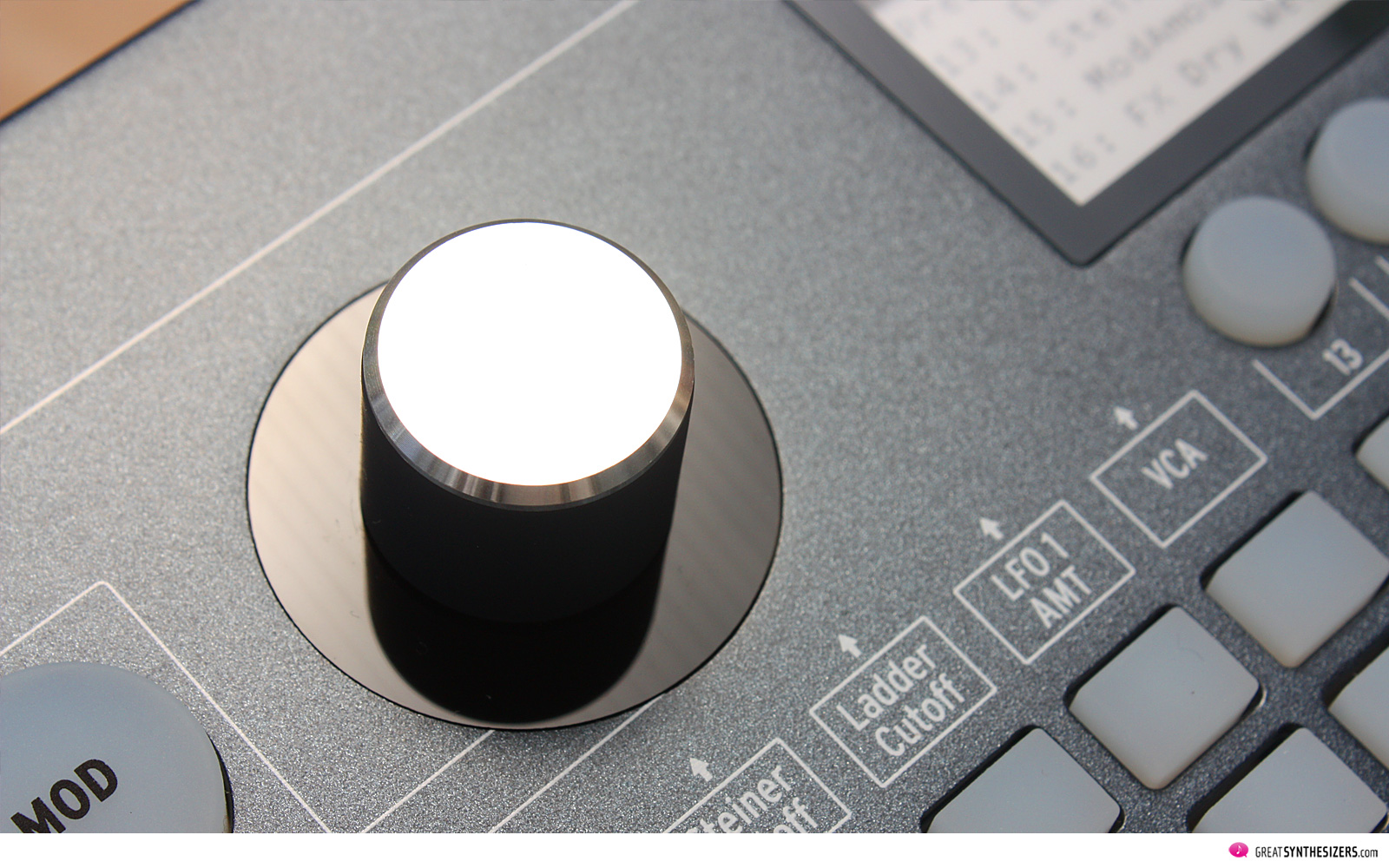
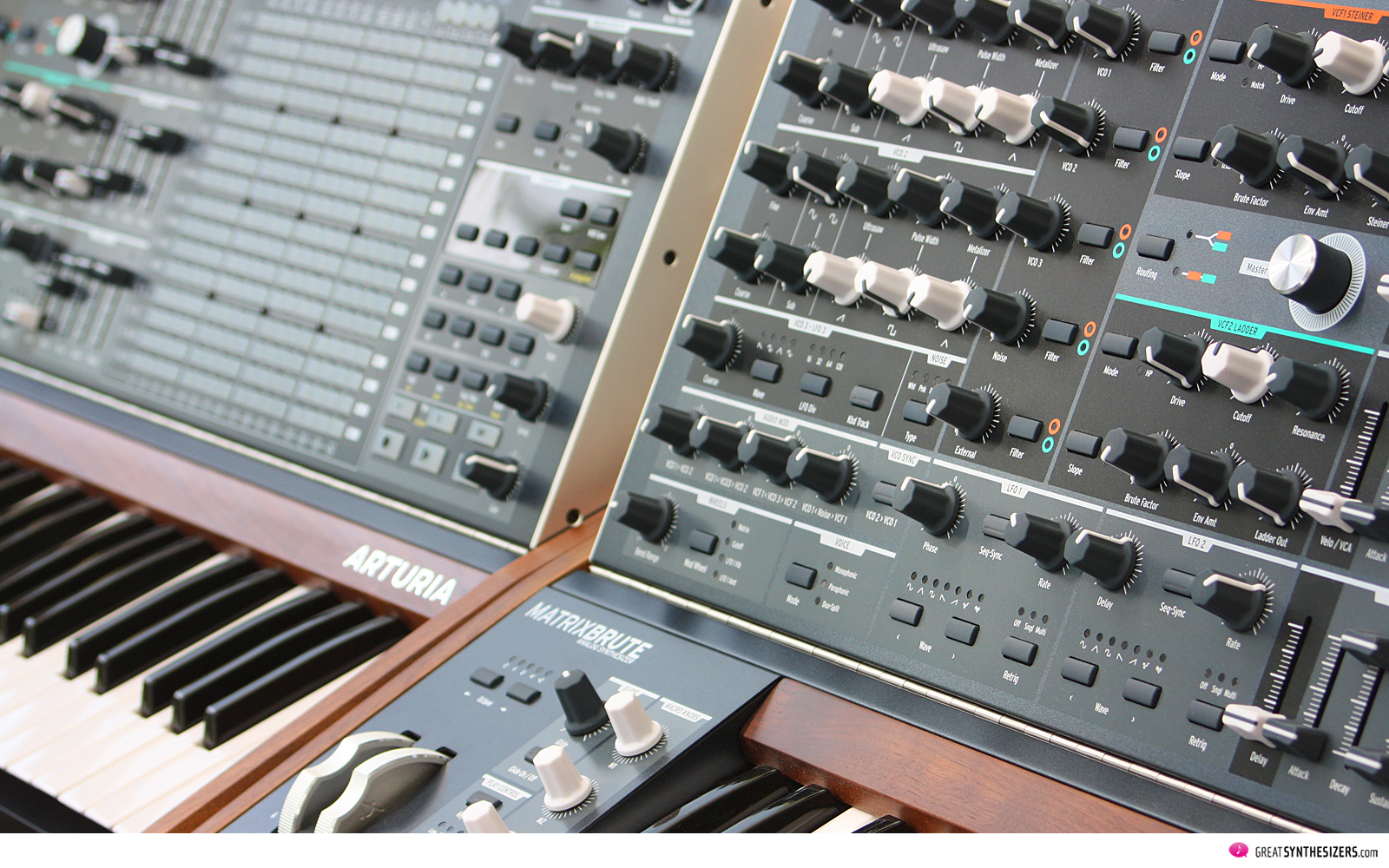
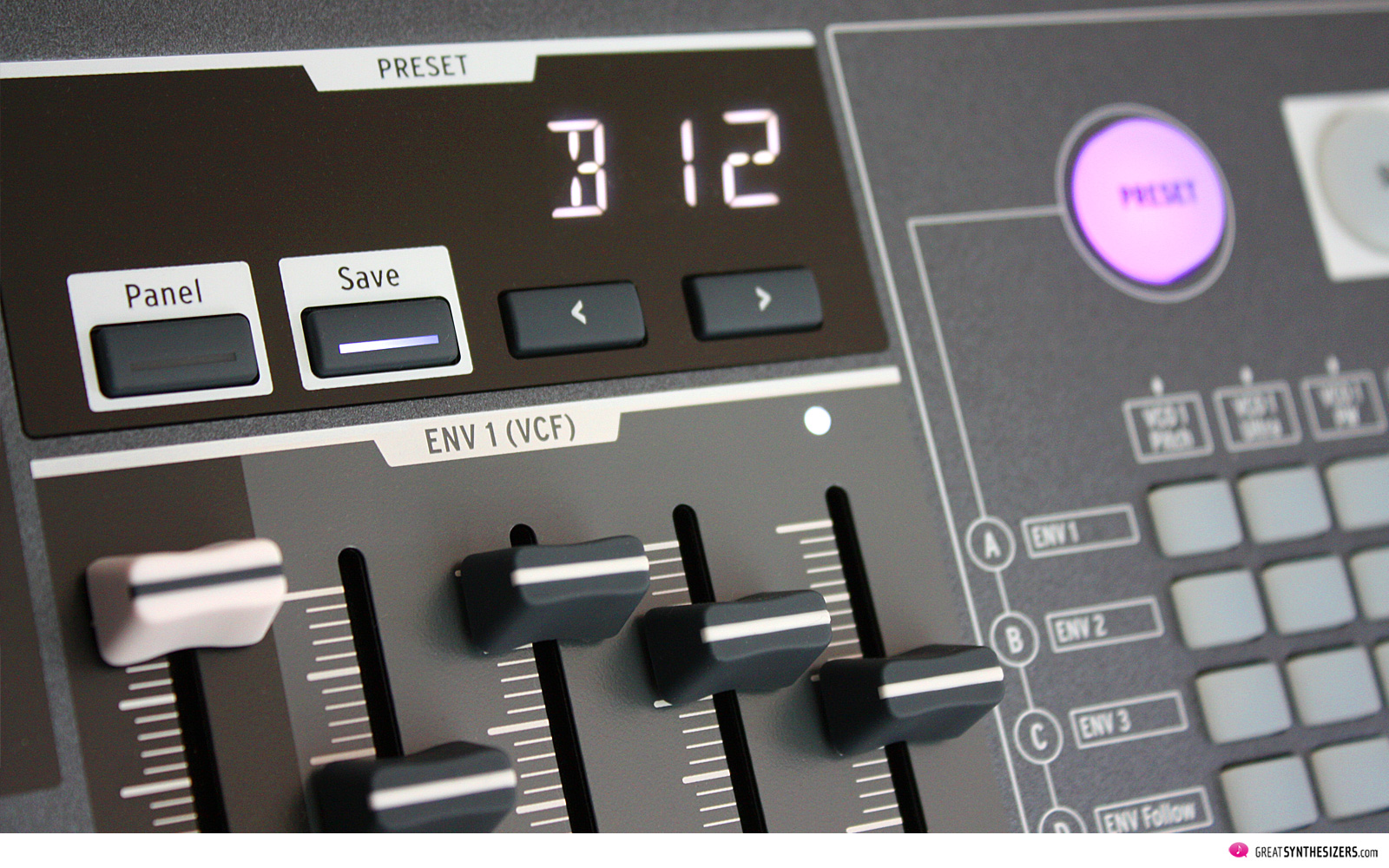

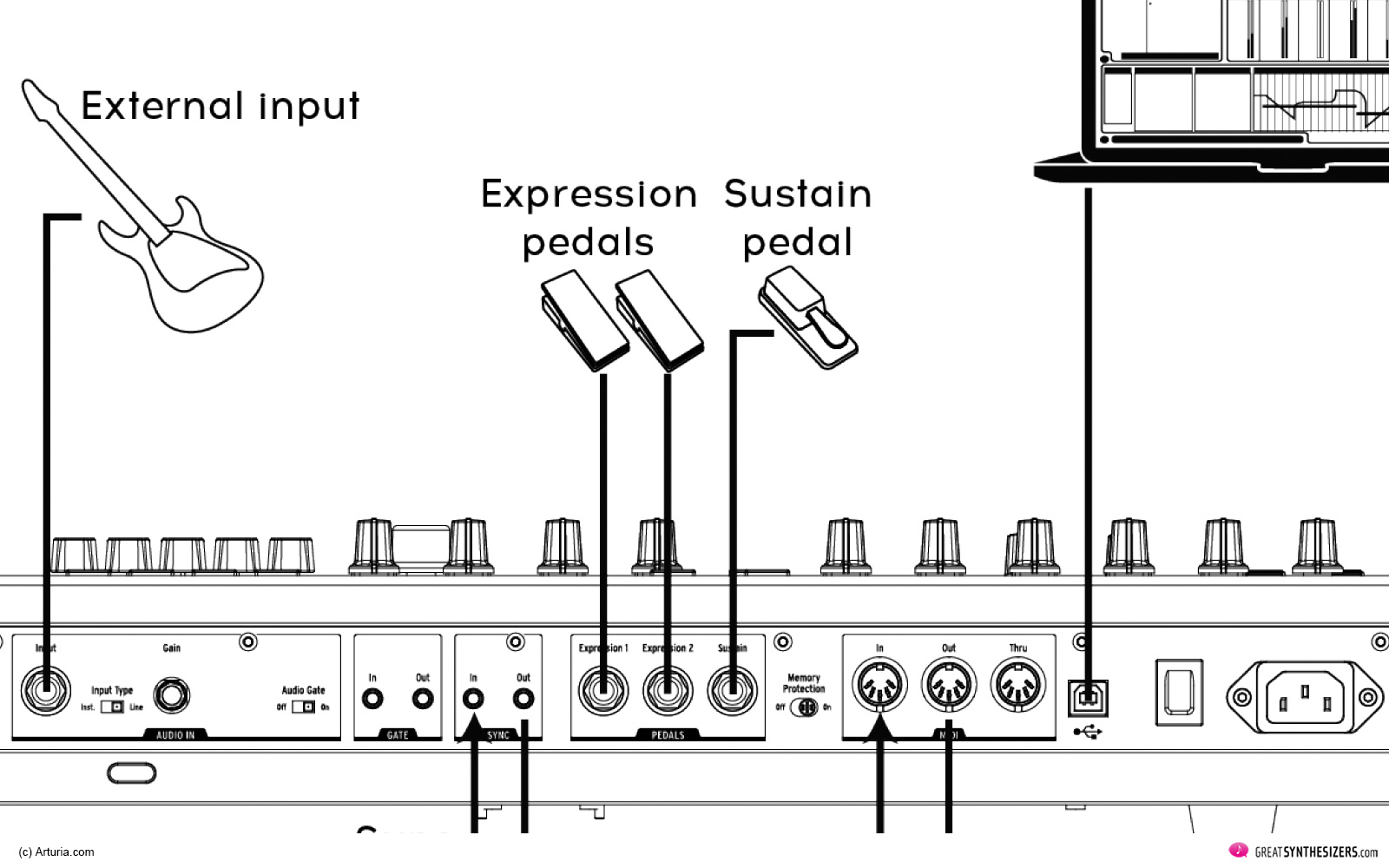
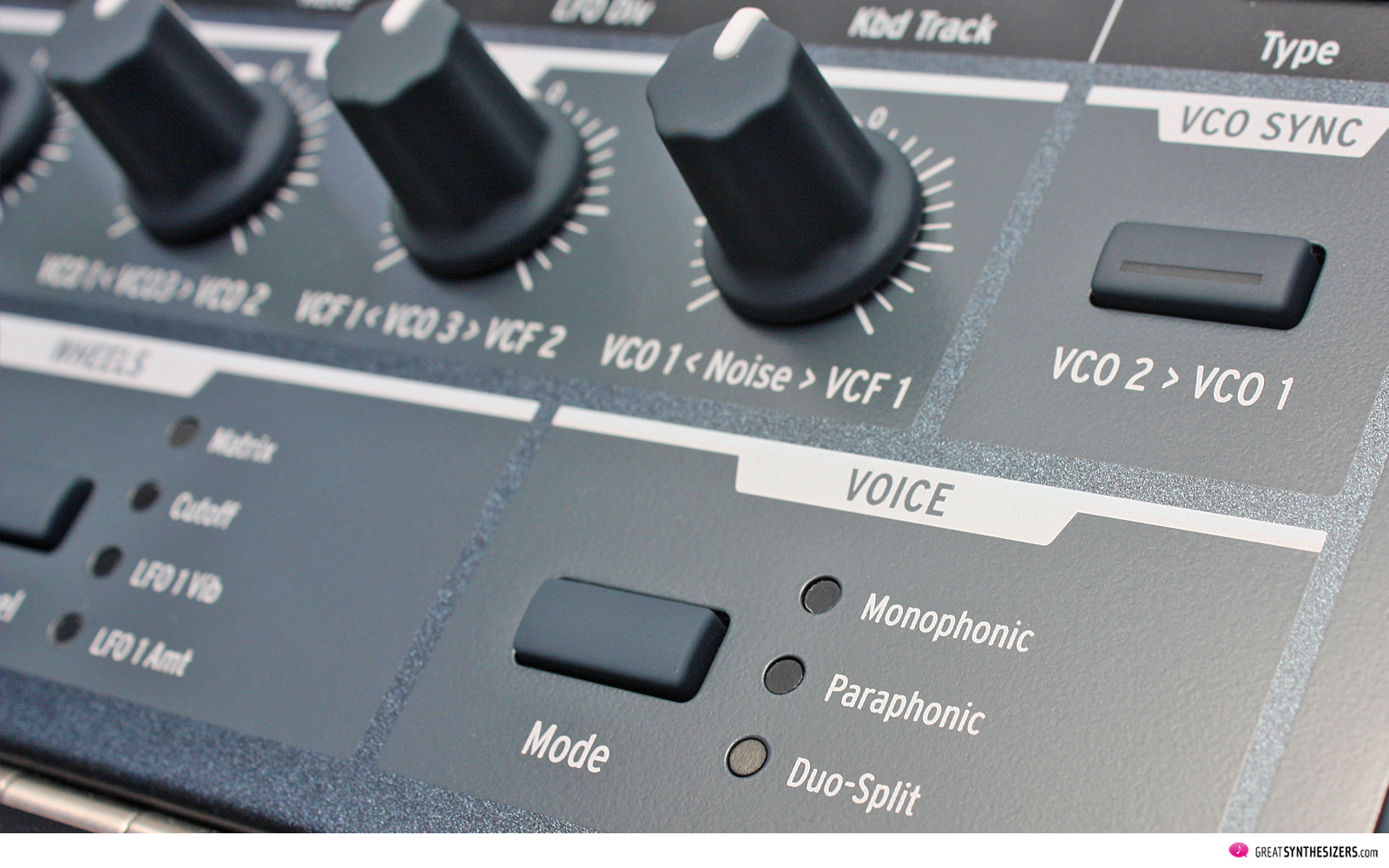
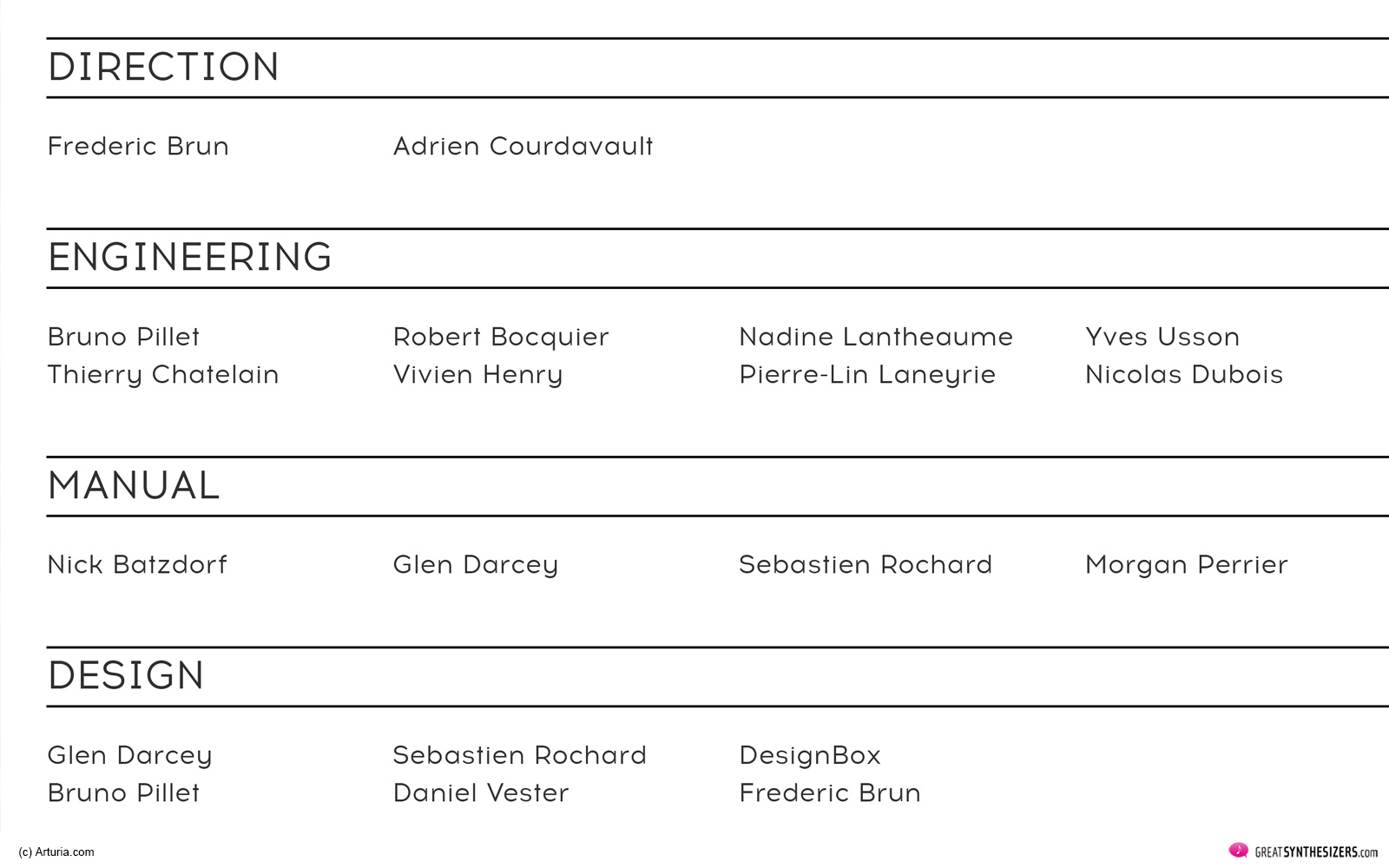
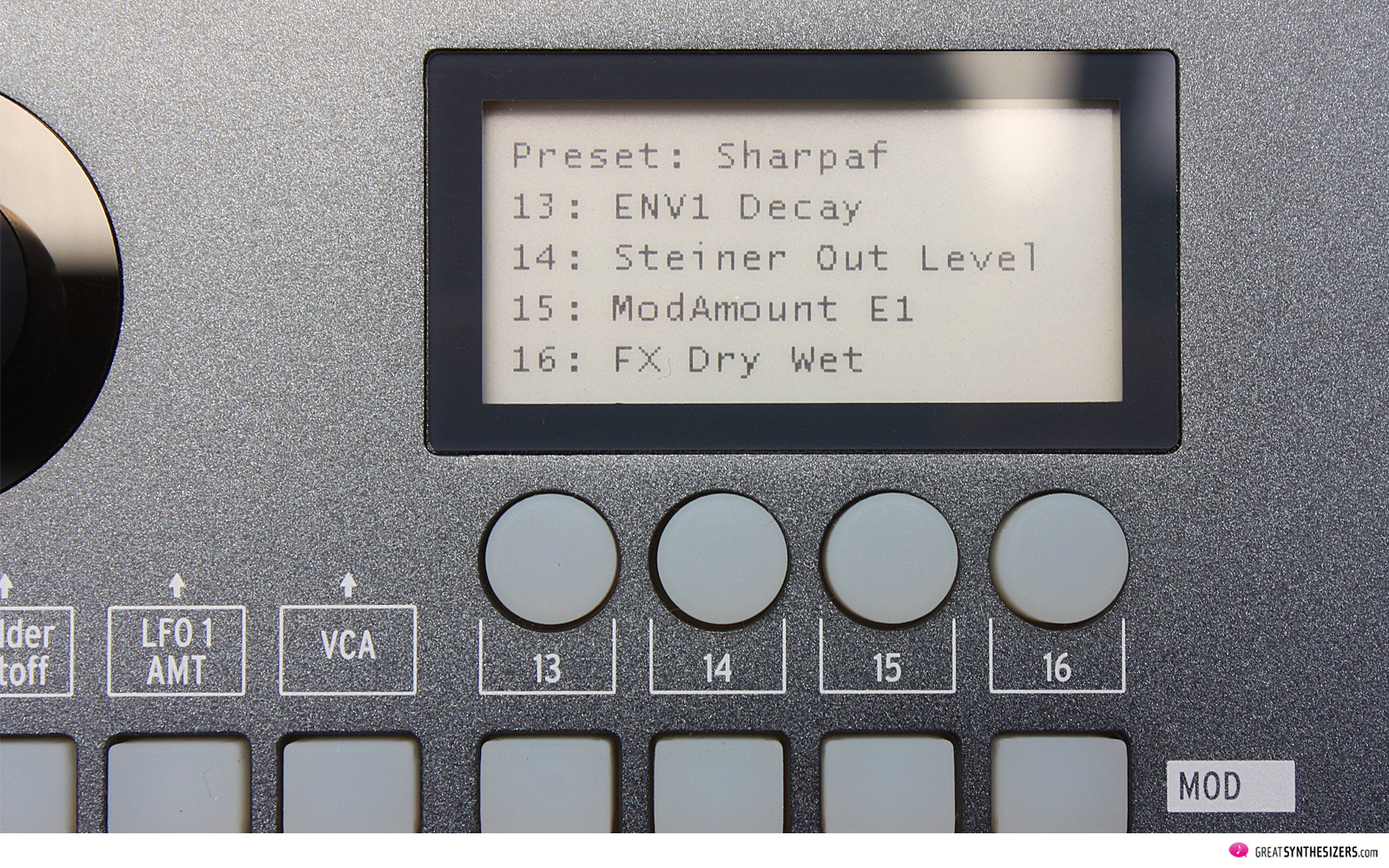
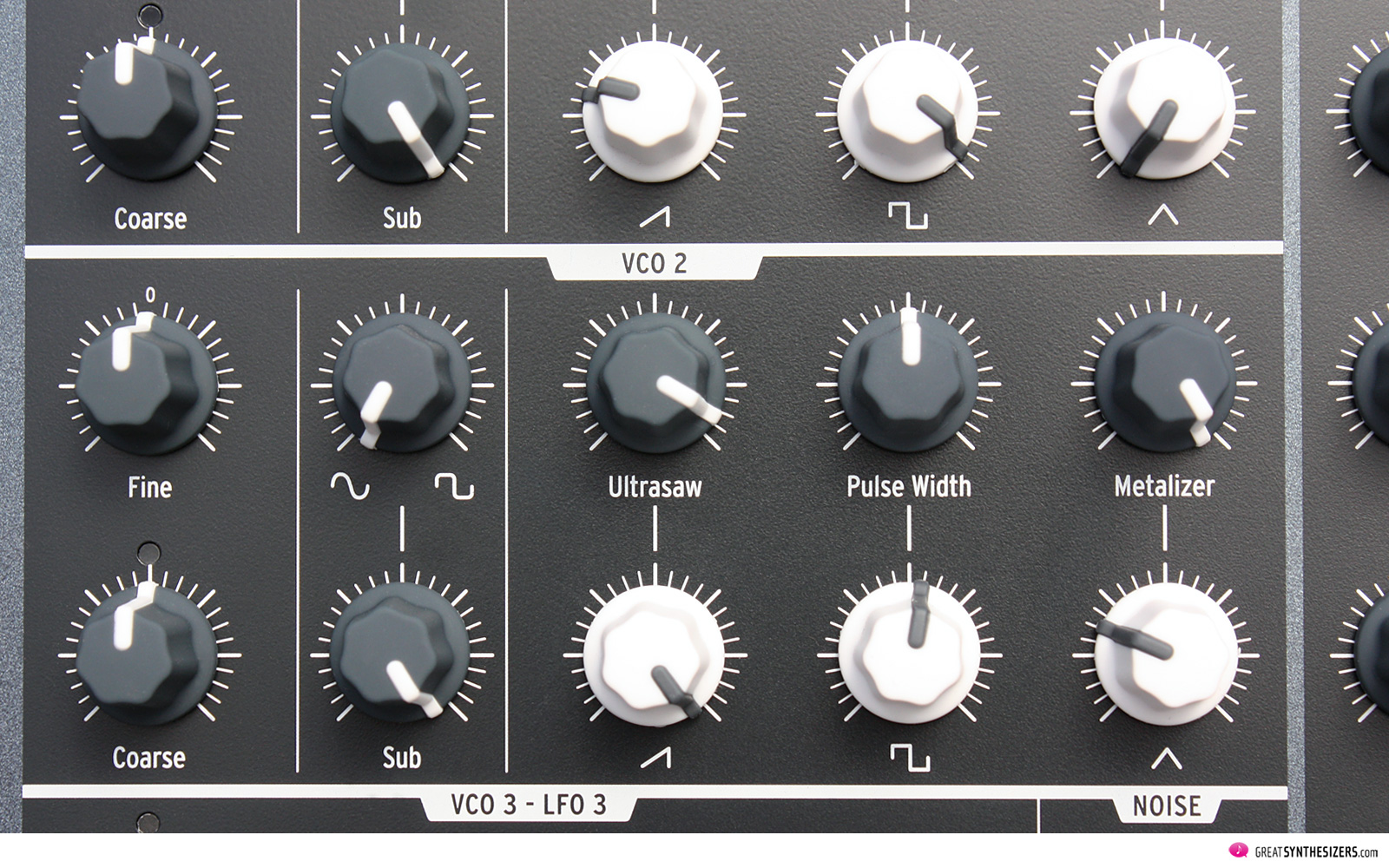

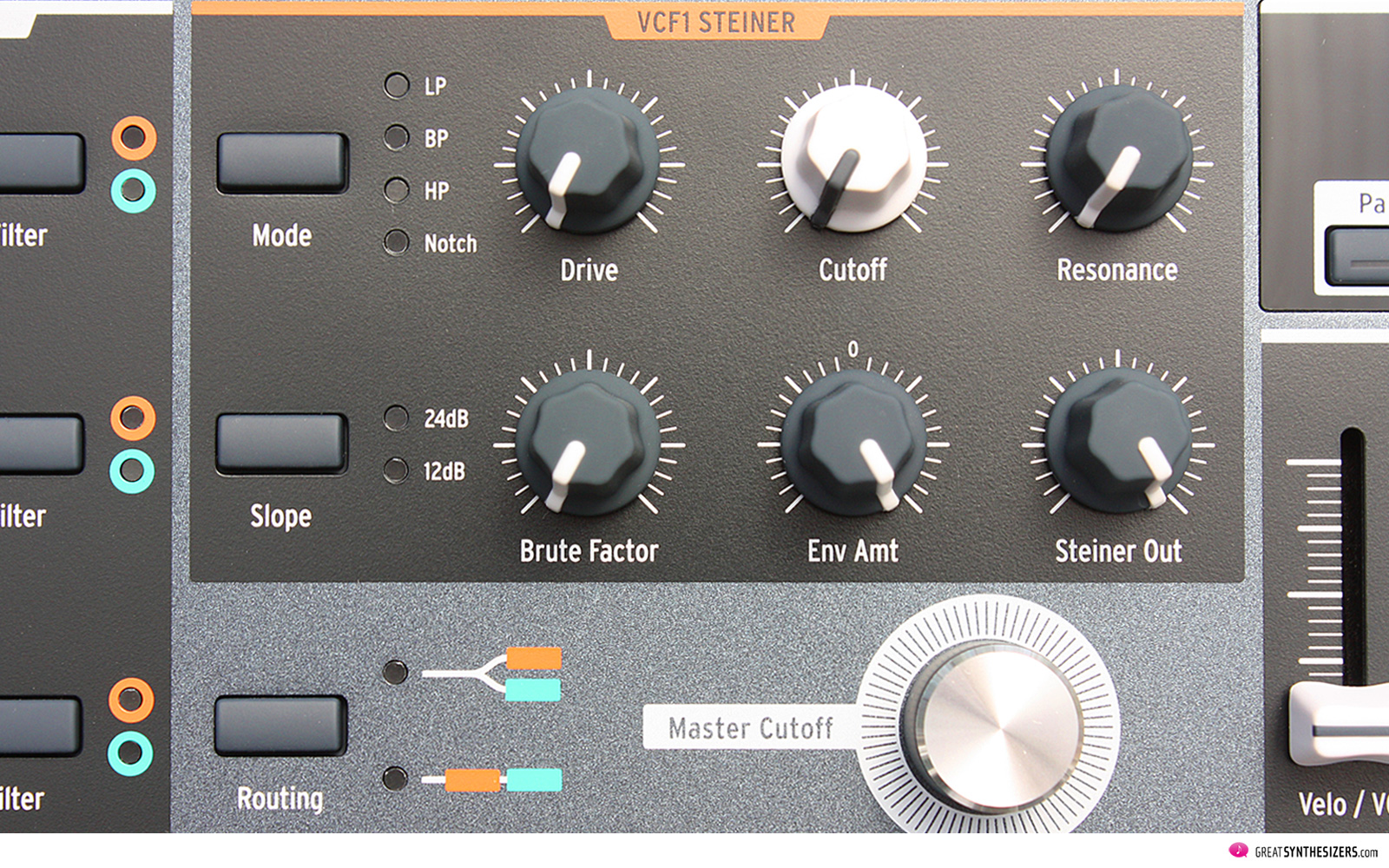
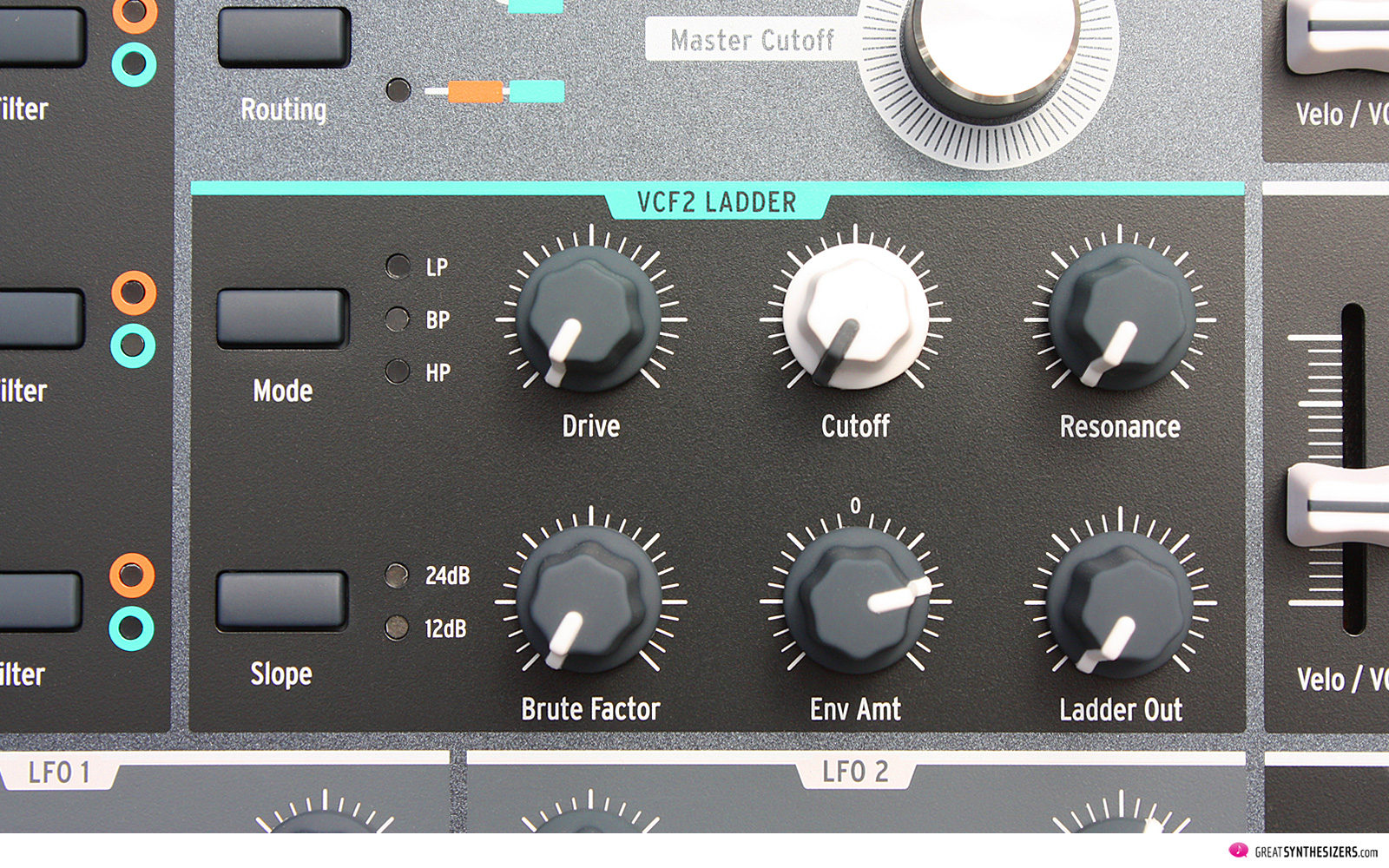
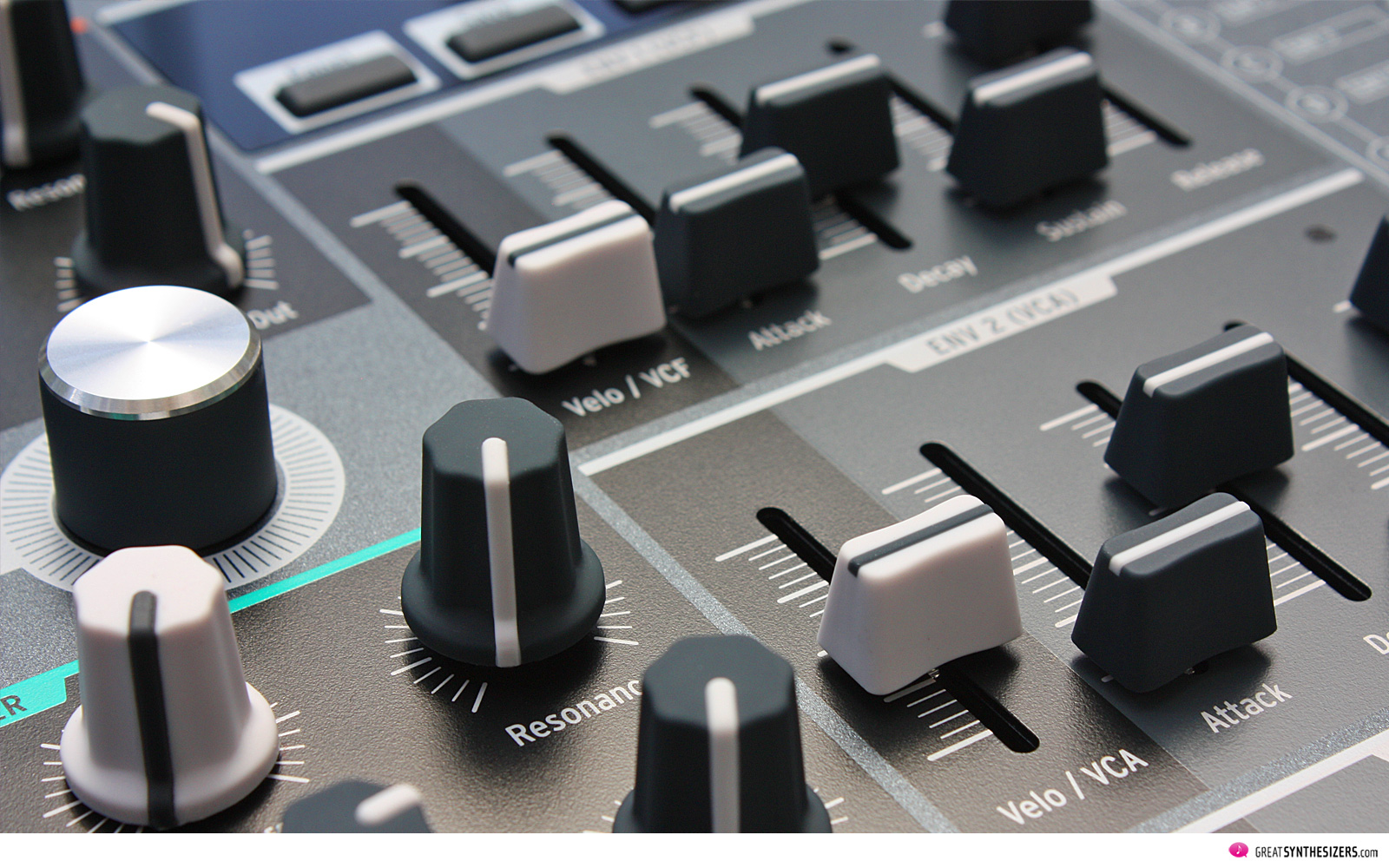

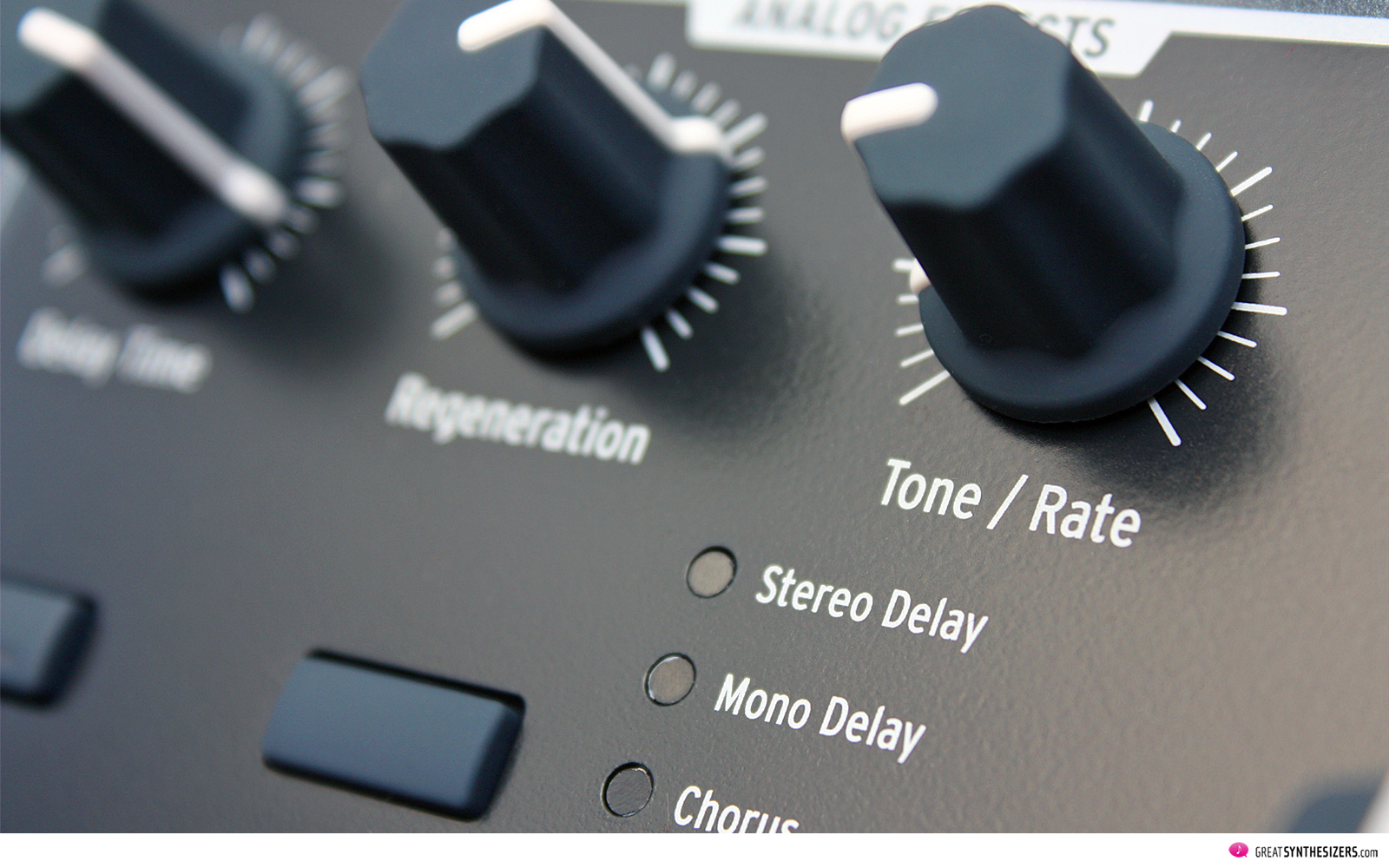
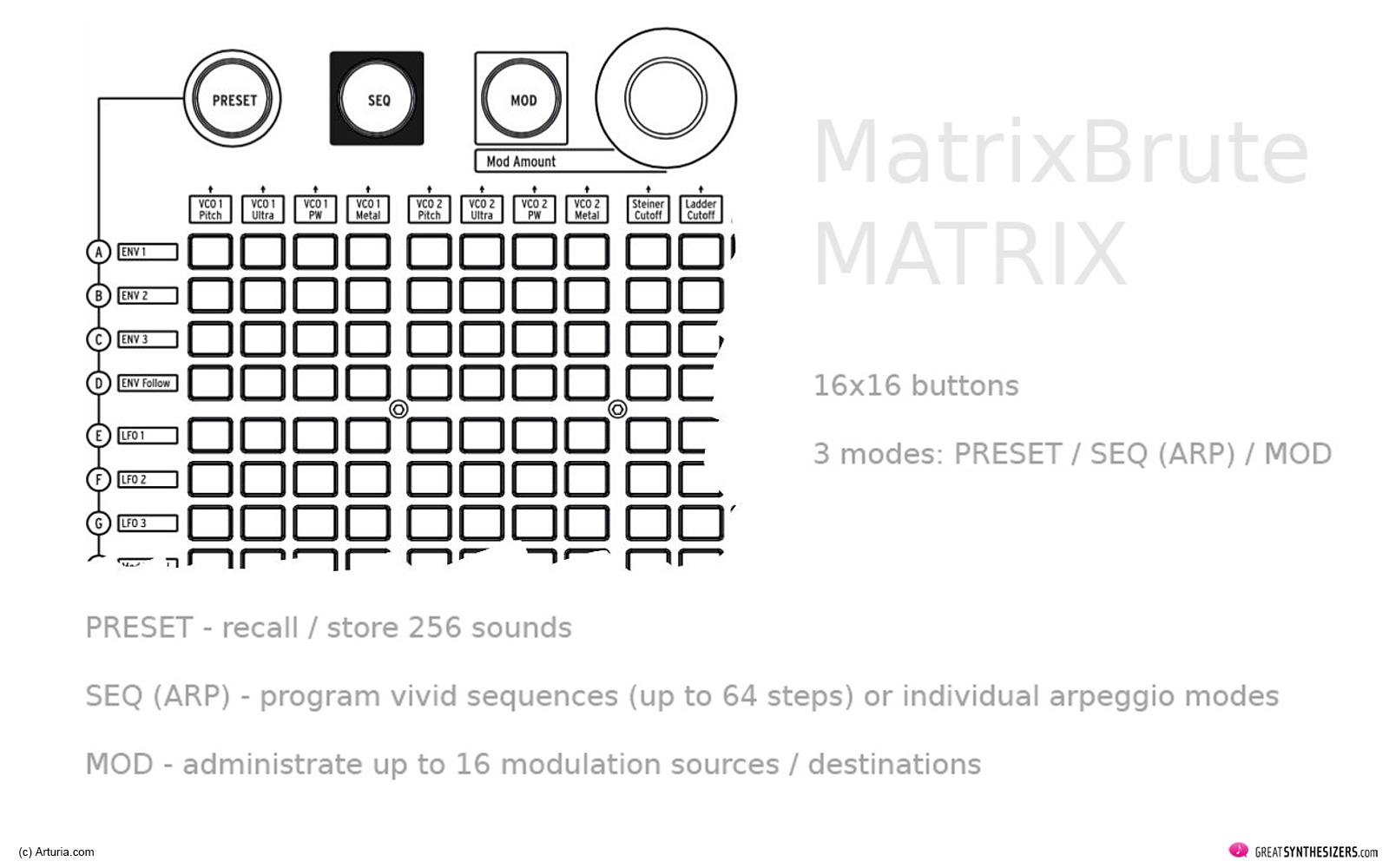

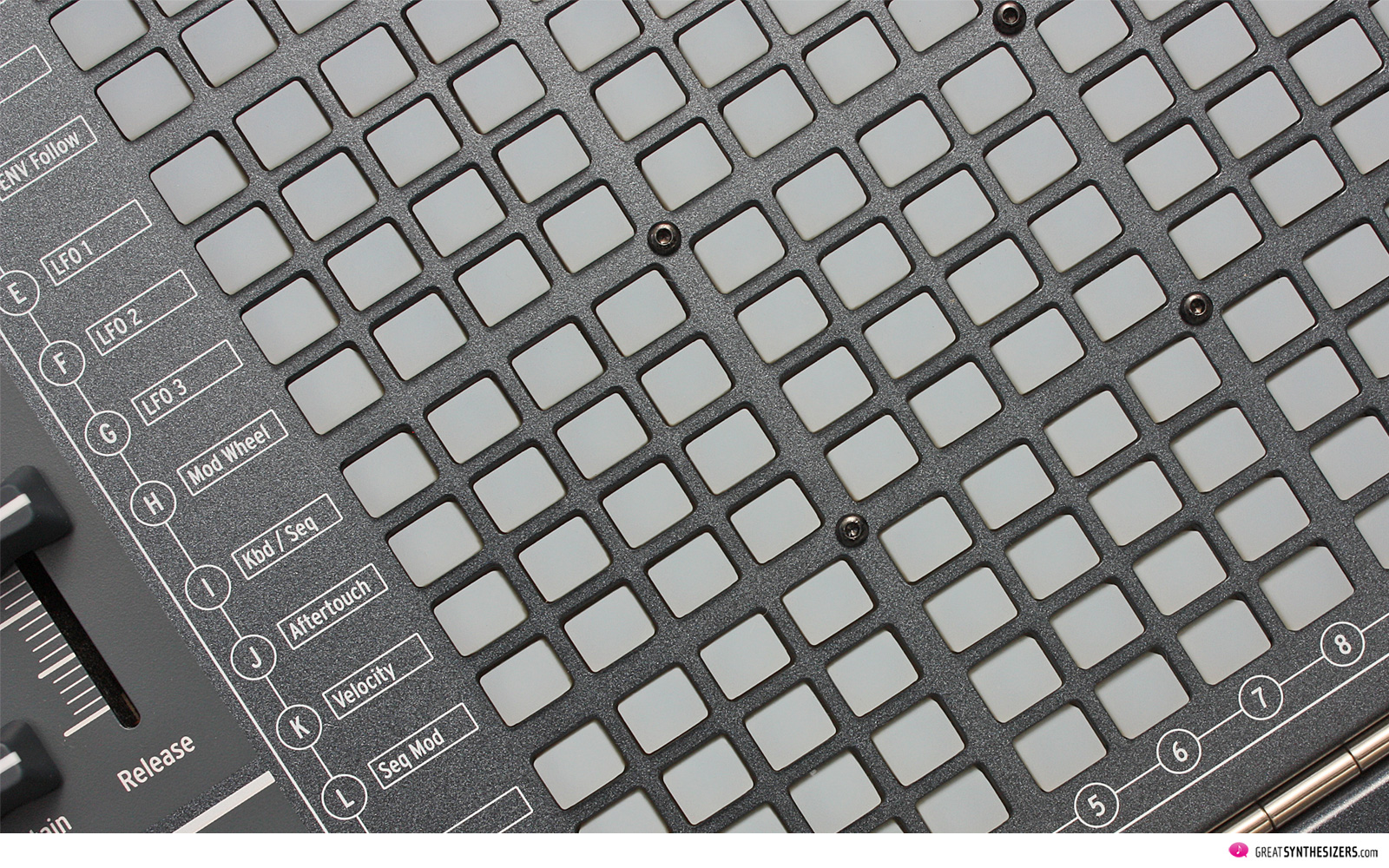
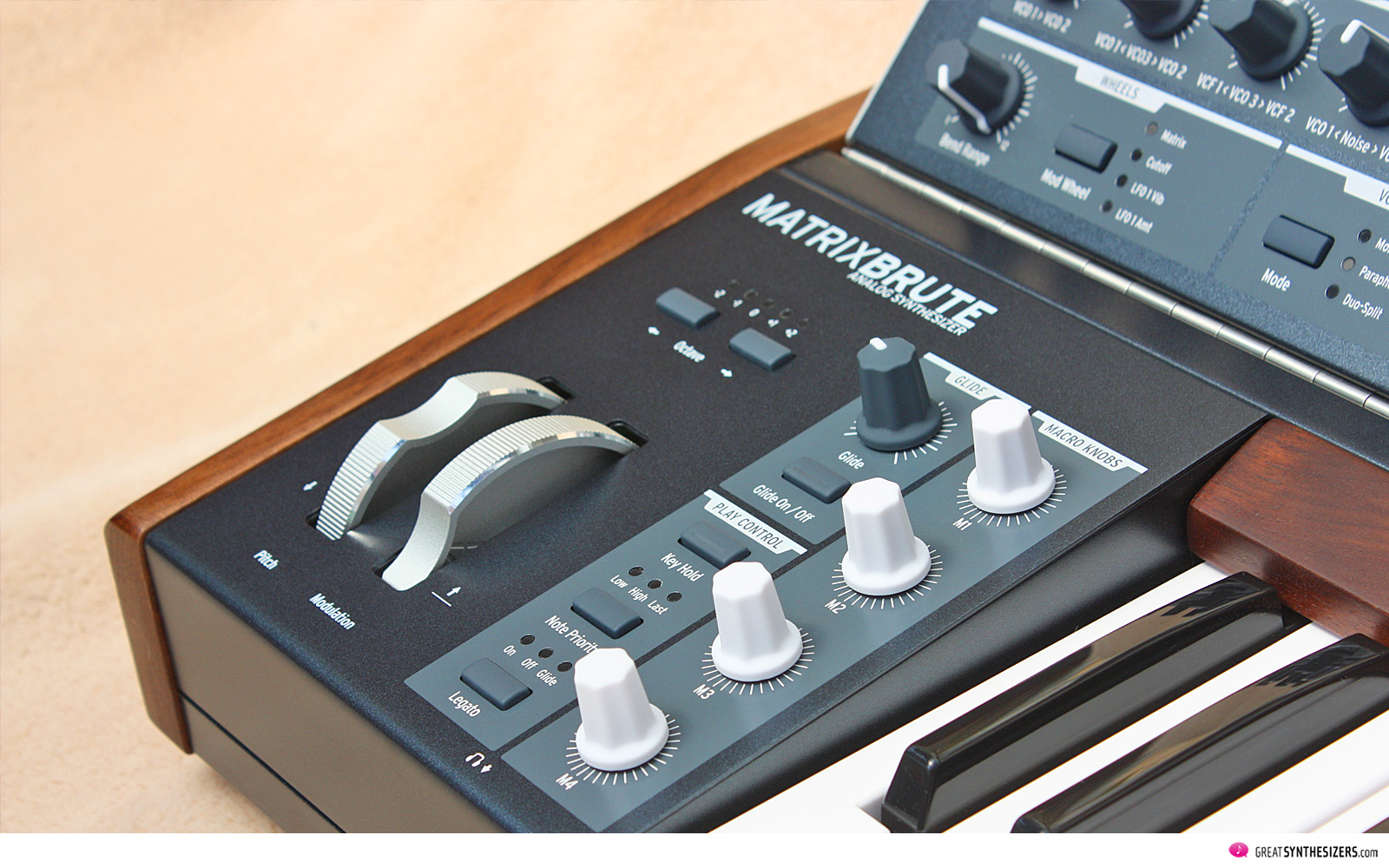
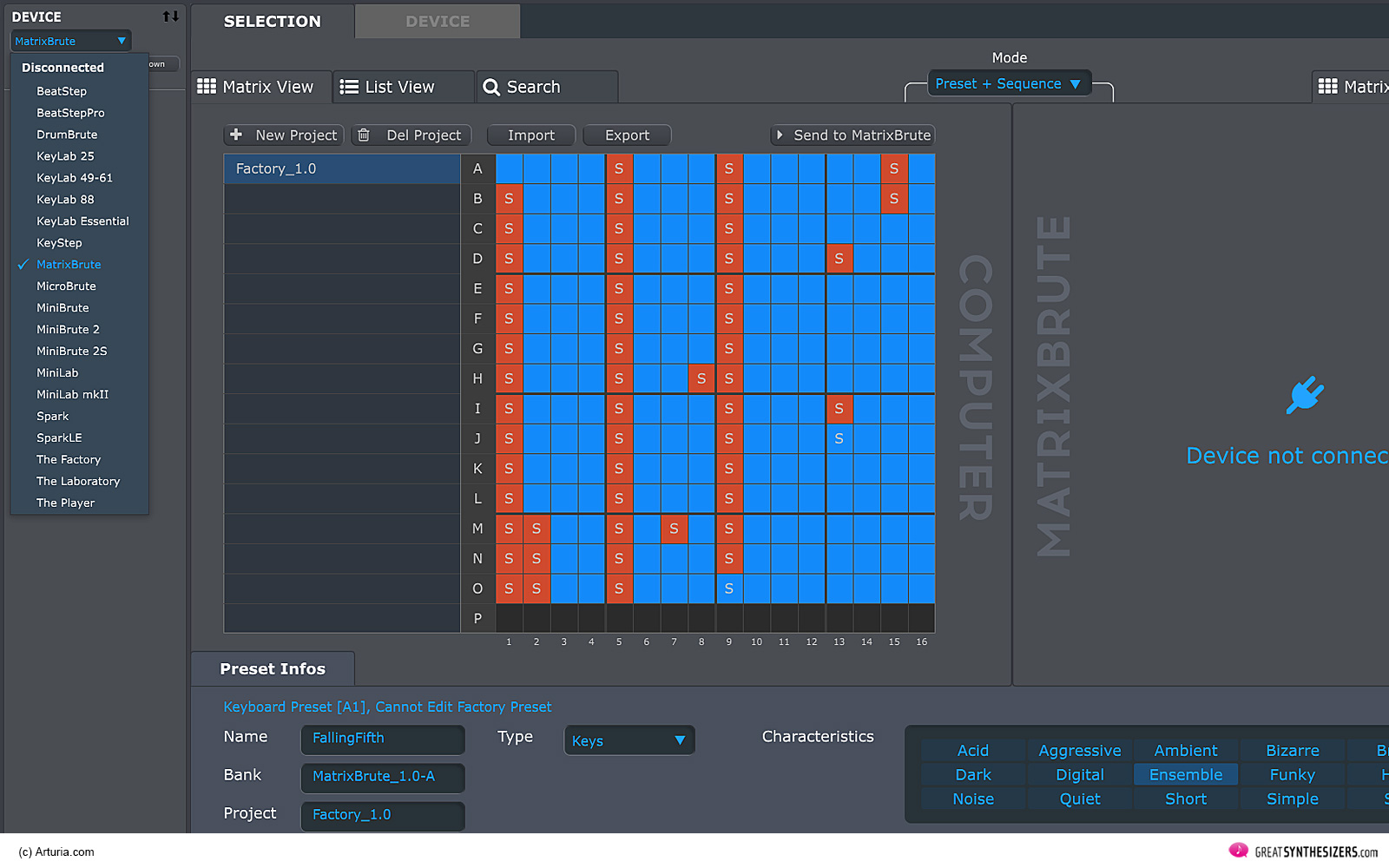
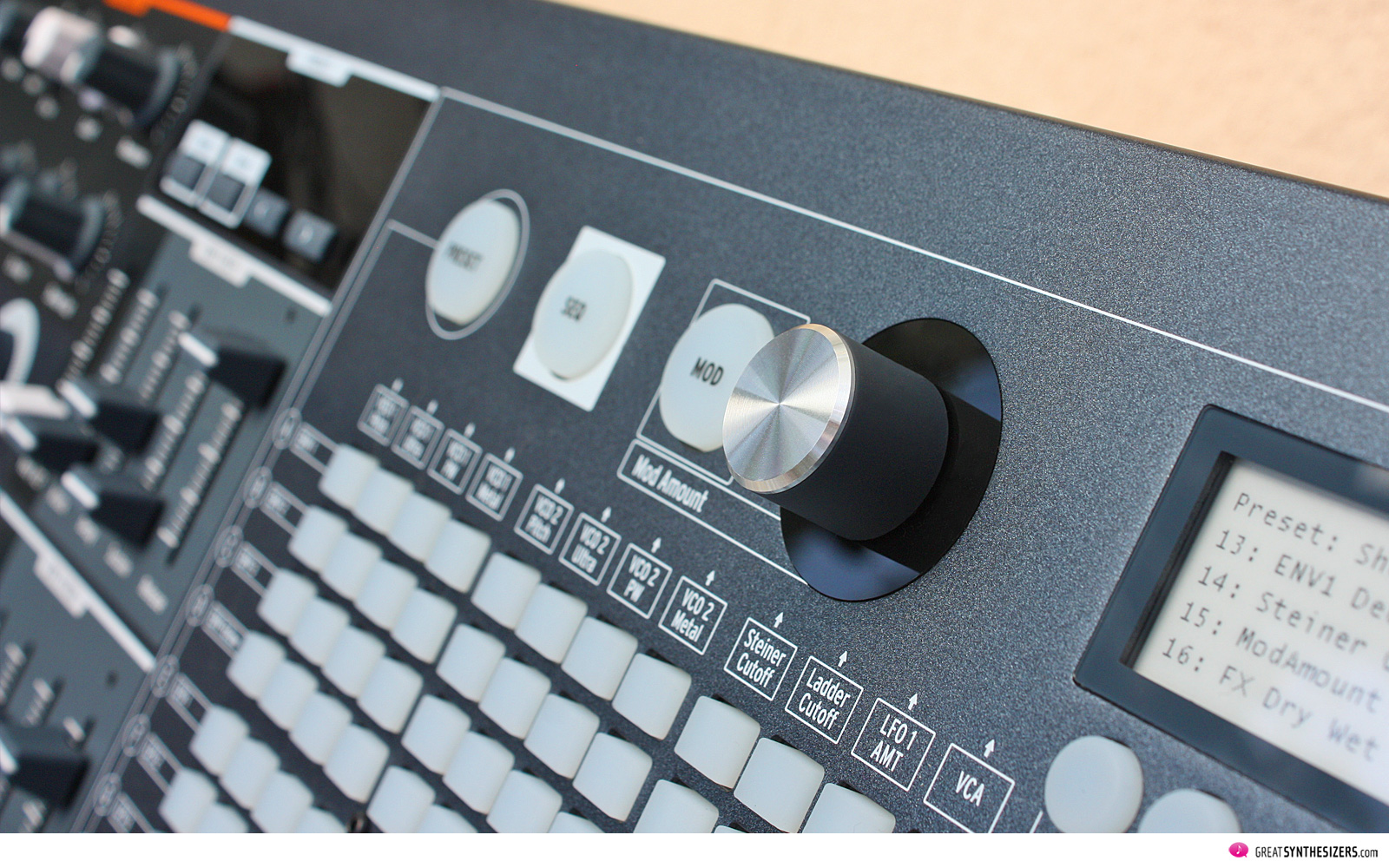
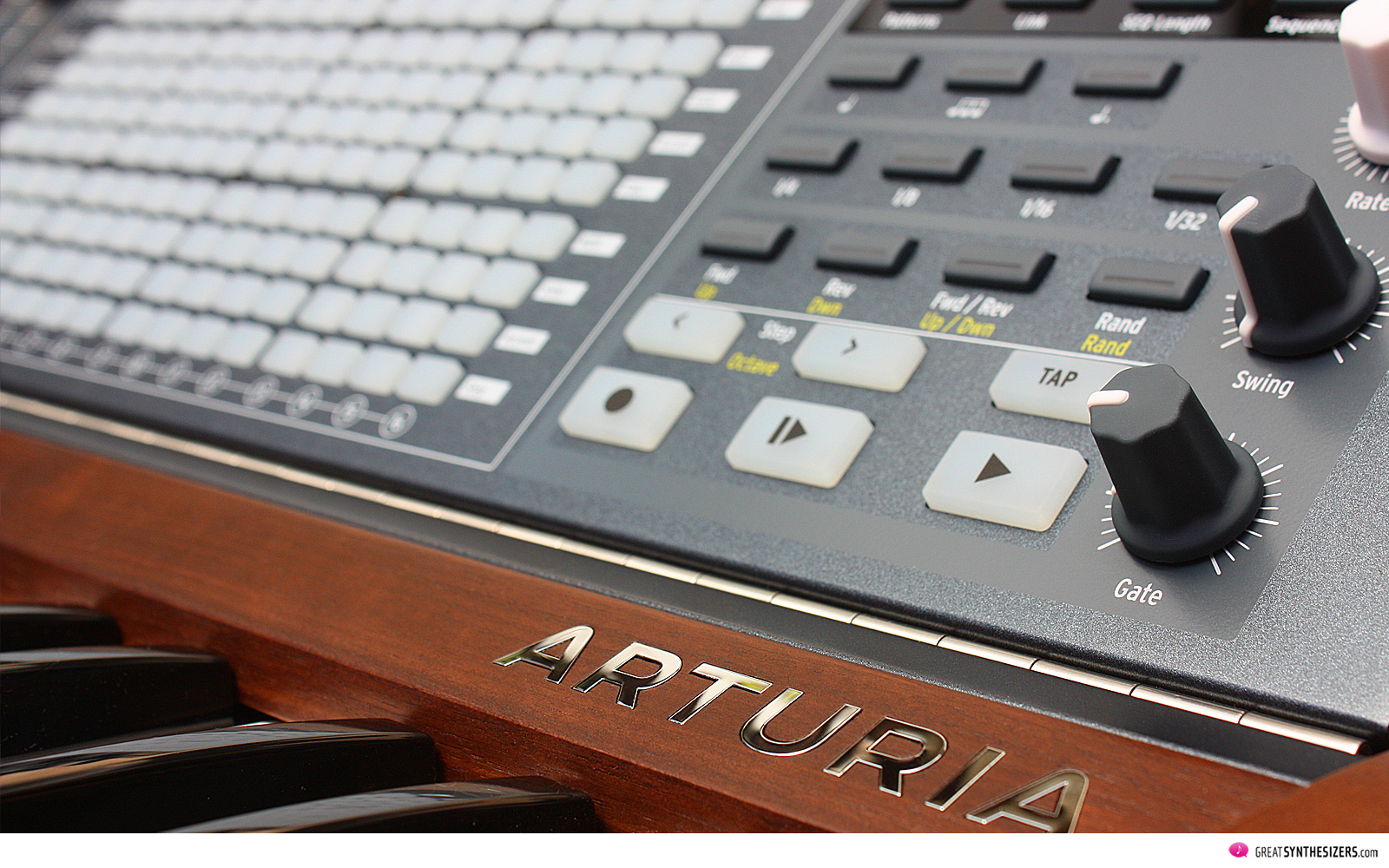
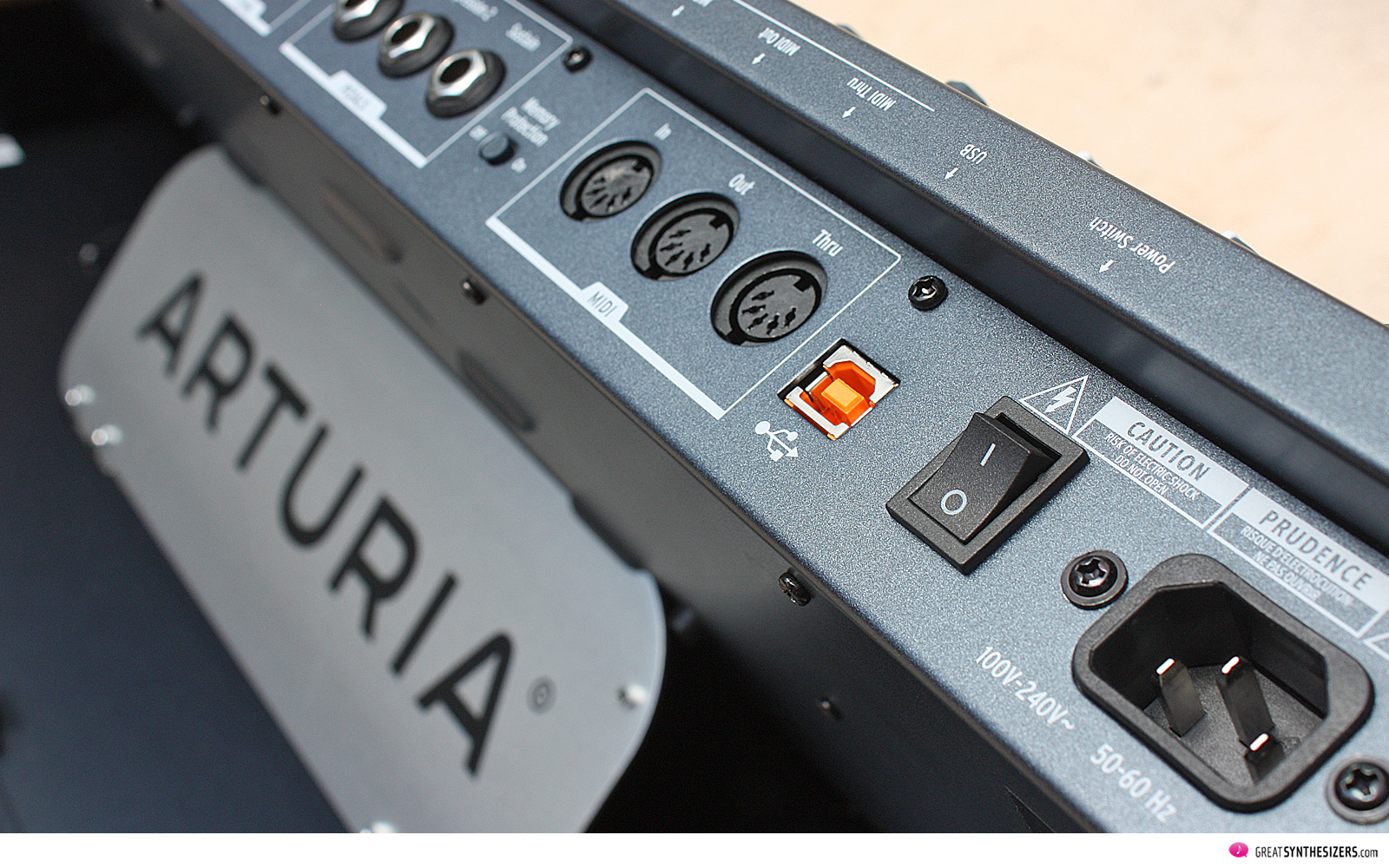
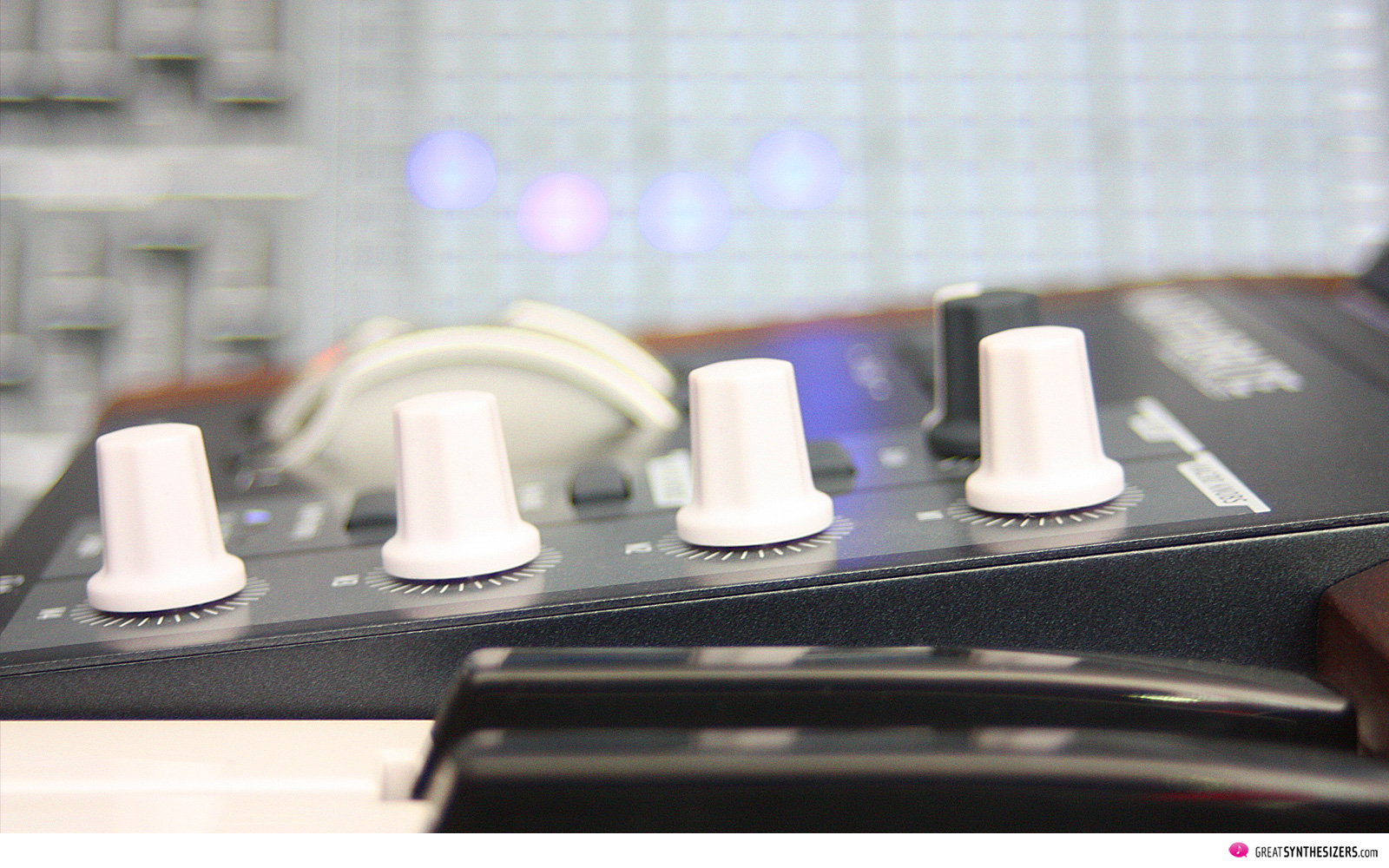
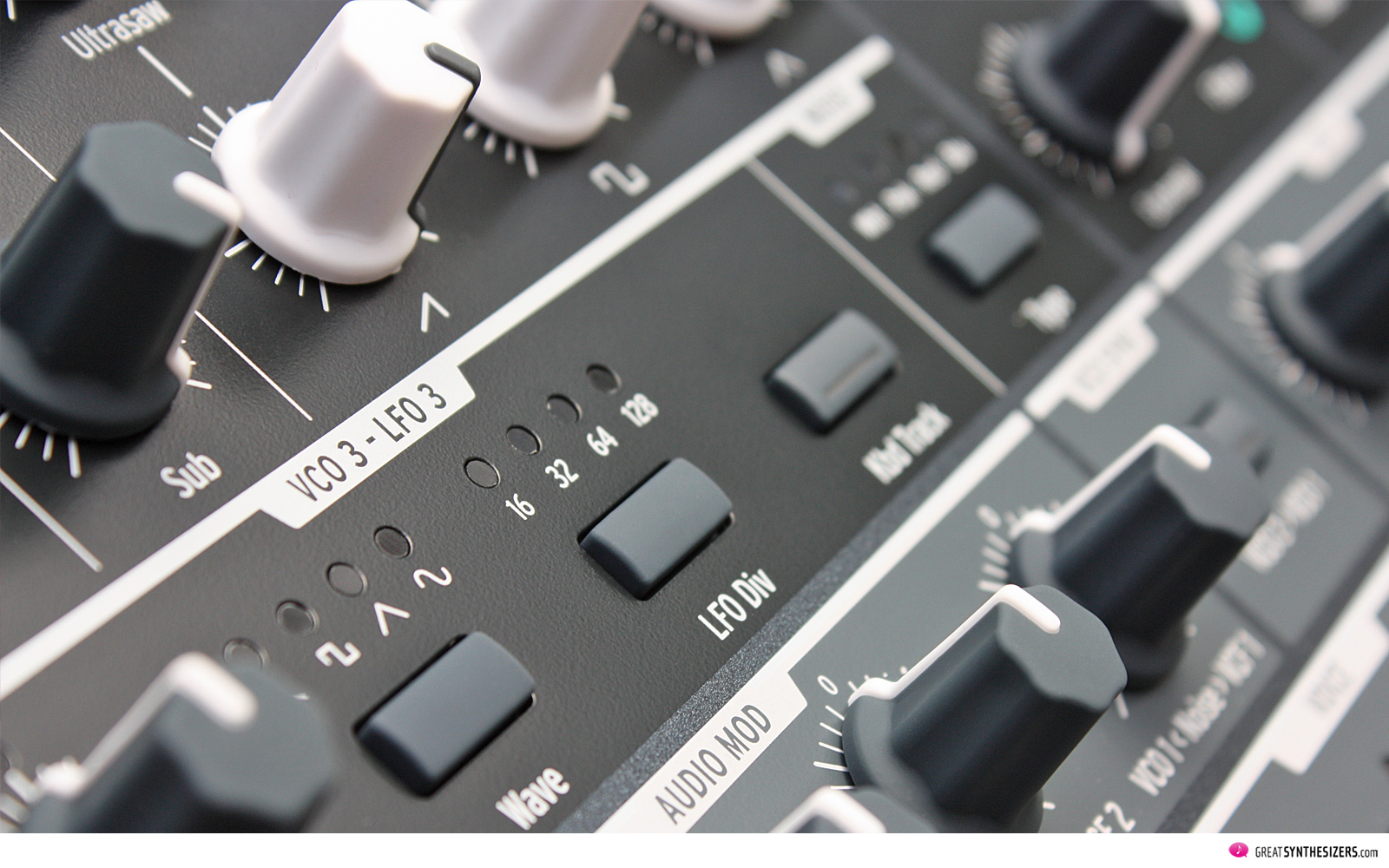
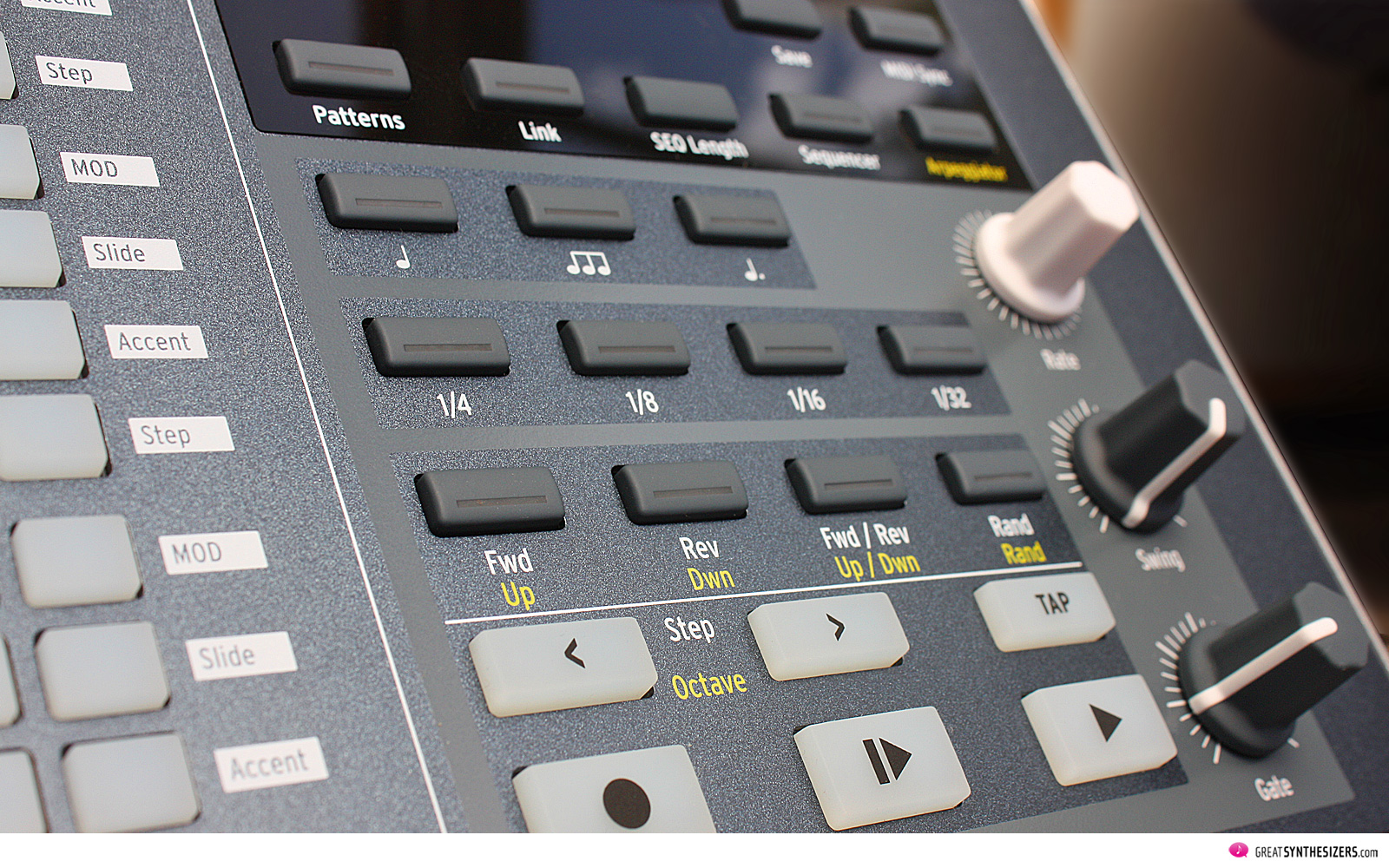
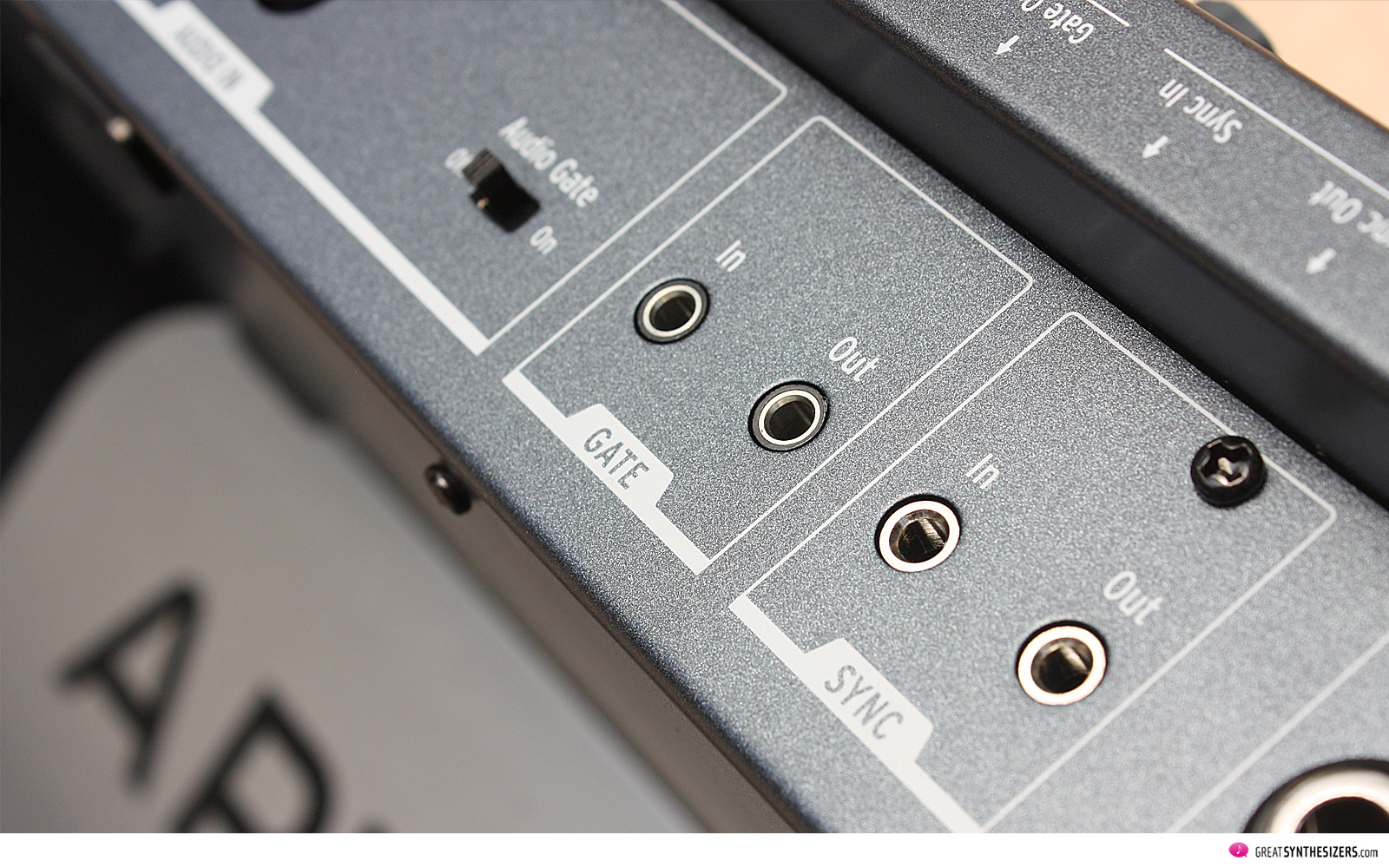
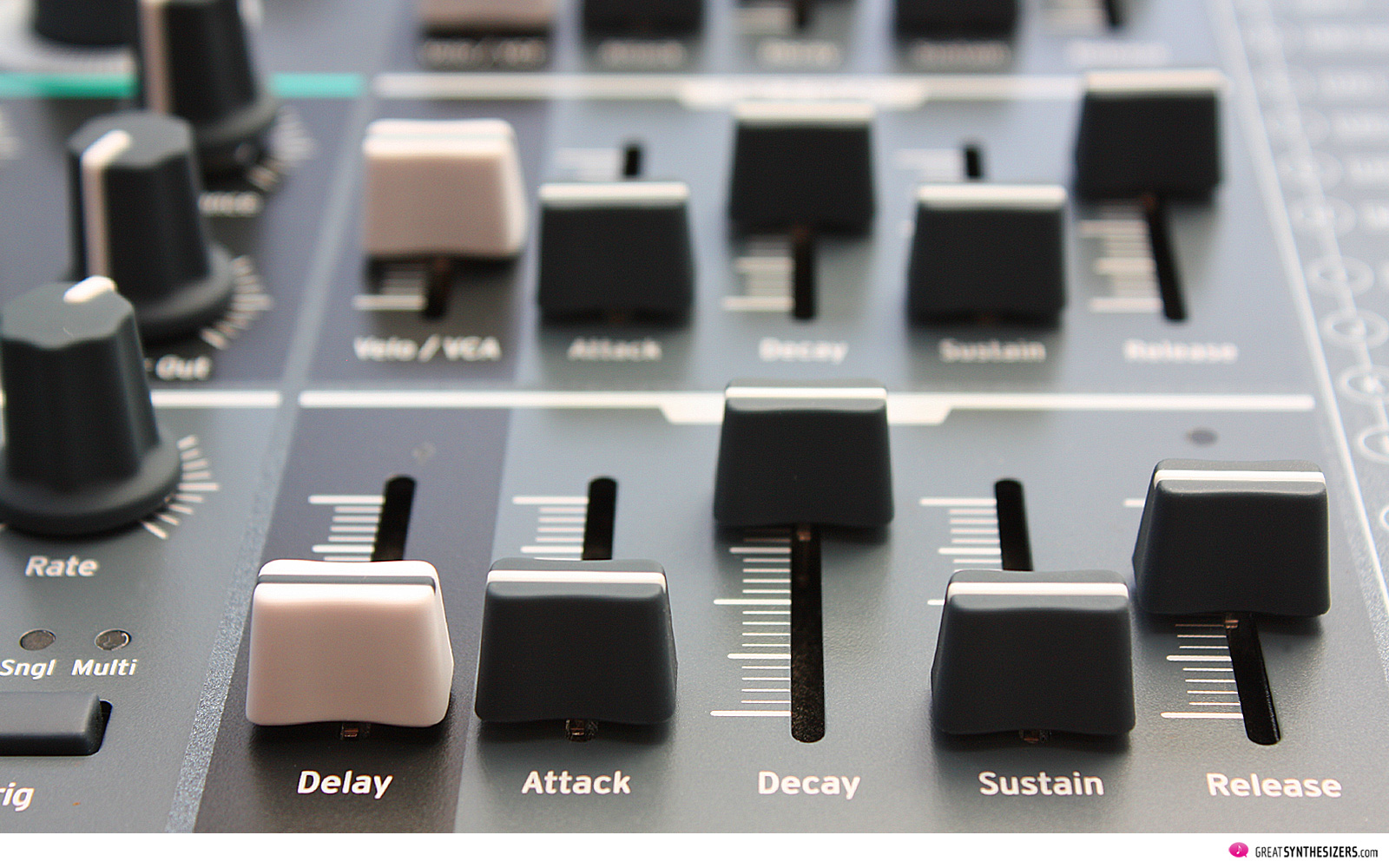
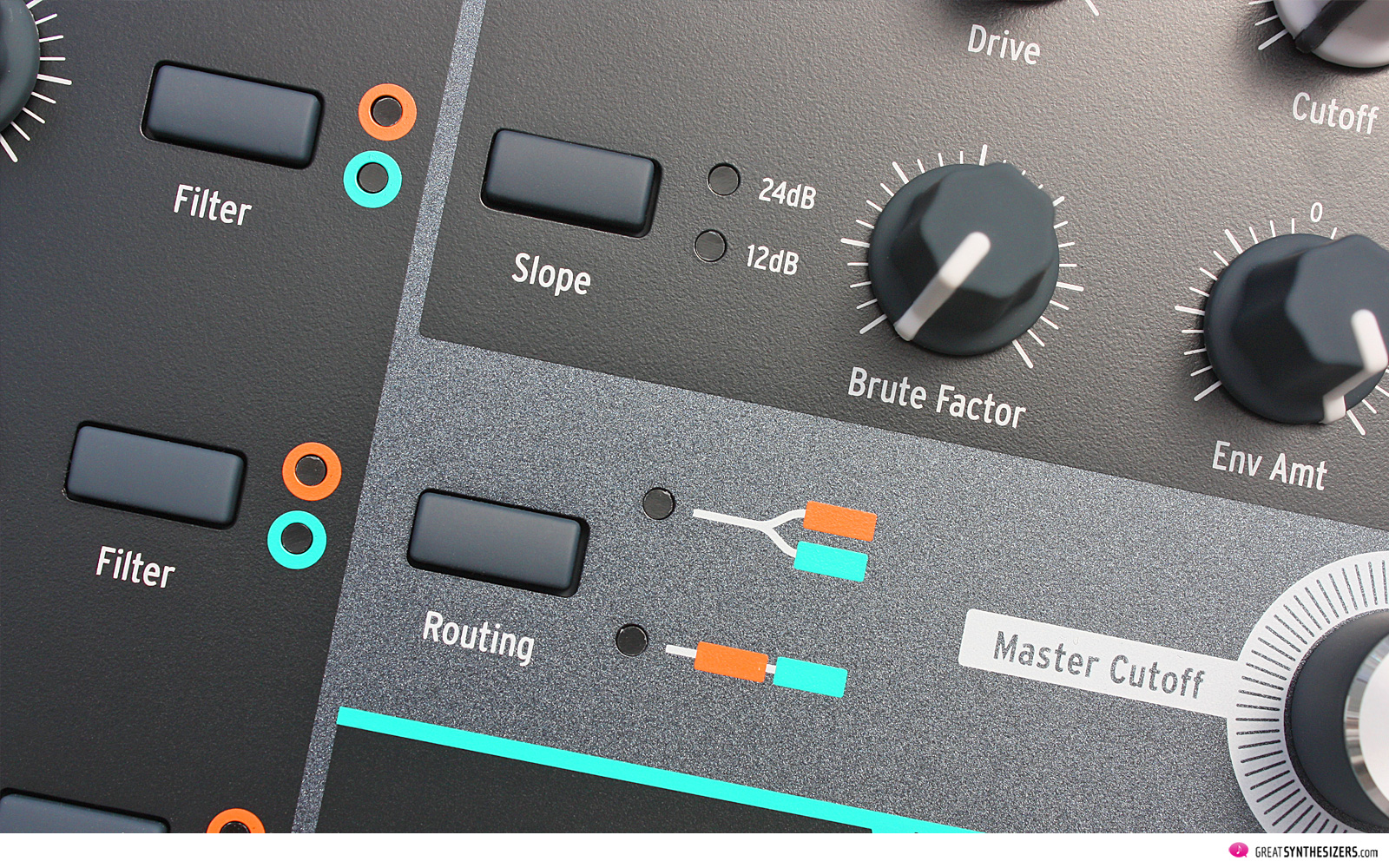
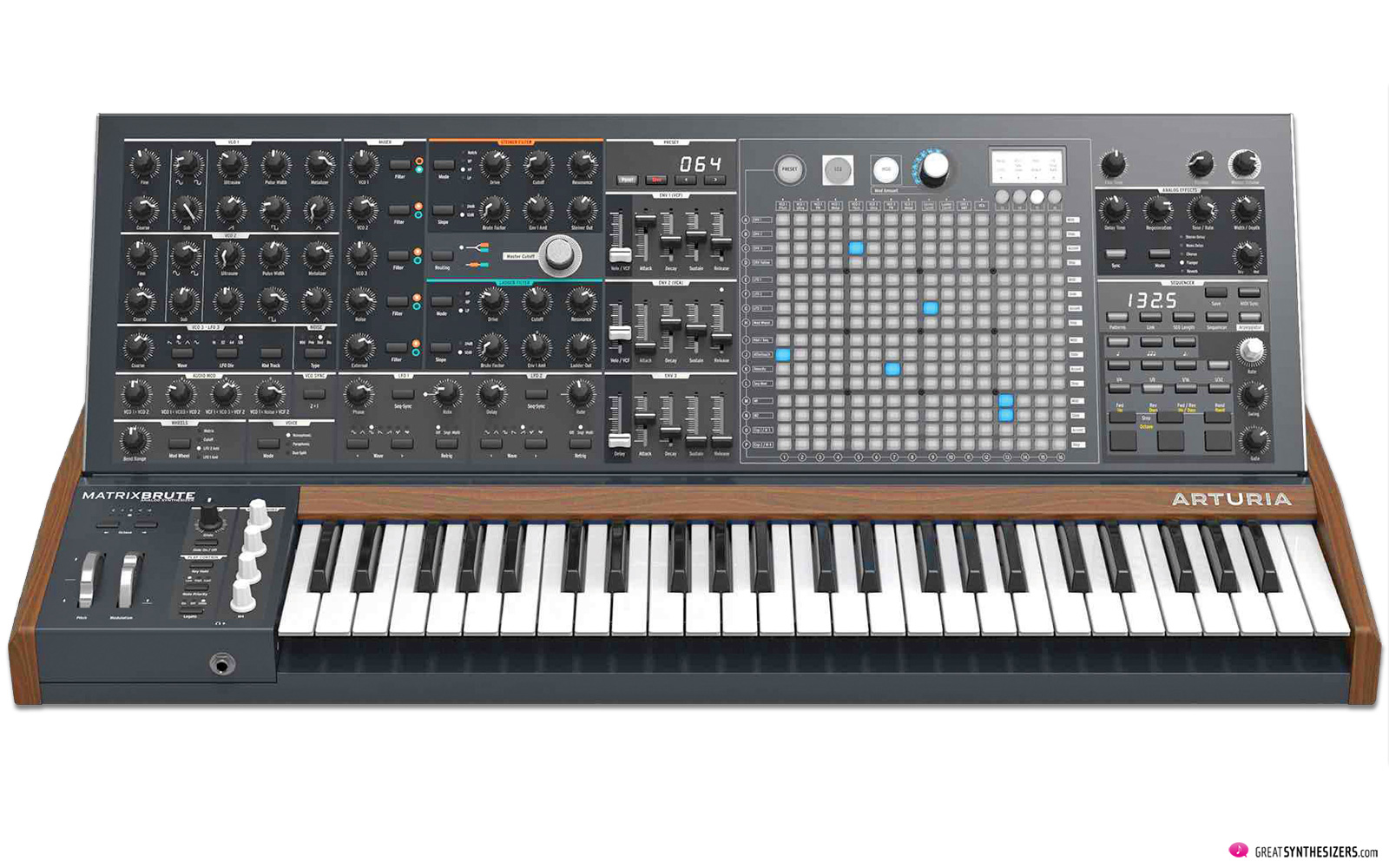
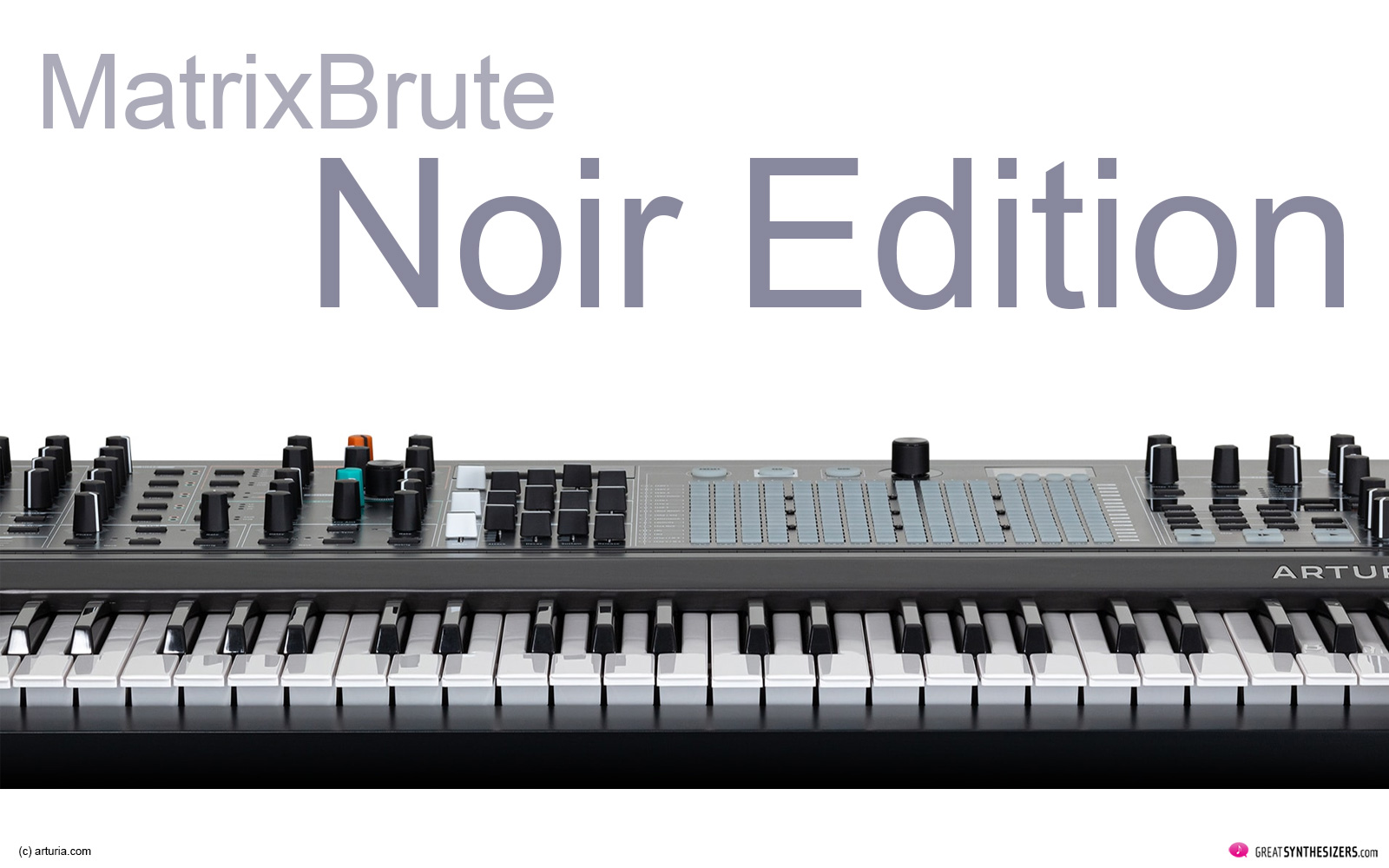
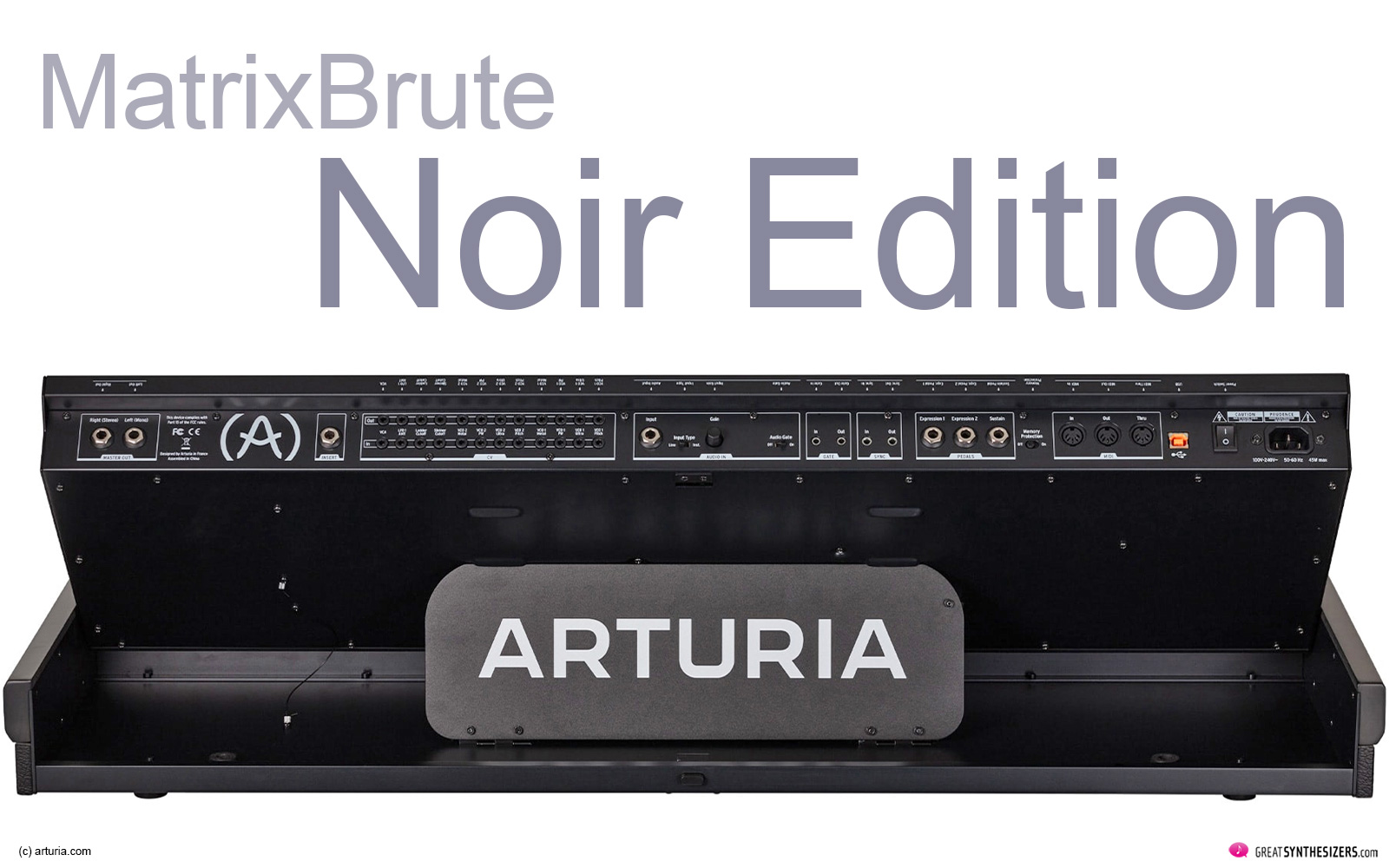
Nice test. I agree with you on everything you say.
There is a nice Program bank for MB here at http://www.barbandco.com (It was not made by me, just to be clear!)
… thanks for the link !
Excellent review and great sound demos! Where did you locate the white replacement knobs? They look perfect!
… located them from my MiniBrute RED (which now has some black knobs – VCO waveforms, etc – which looks white good as well). MicroBrute RED would be another white-knob-source … and possibly Arturia themselves :o)
ooh la la!
The next episode of this review is here :
http://greatsynthesizers.com/en/general/arturia-matrixbrute-analog-sound-with-warmth/
Theo,
Could you relay your experience on the lack of punchiness of the envelopes on the MB? And the Minibrute 2 for that matter.
… hi Jeff … I’m not sure if I can conclusively answer your question. Modern analog synthesizers are quite different from vintage synths in many ways. One aspect the lack of puchiness of the envelopes. Then there are those higly precise voltage controlled oscillators. Weak amplifiers another point. All together resulting in a modern, but in some way stereotype analog sound that misses the dynamic range well known from vintage classics. Still pleasant, flexibel and extremely useful, though – I don’t wanna condemn modern synths. I’m just not sure wheather the lack of punchiness is due to those MatrixBrute / MiniBrute 2 envelopes or not … or maybe due to those modern VCAs, or maybe a combination of both (and other factors). Guess we’d need to ask a skilled technician (o:) Cheers – Theo
Hi, is the soundpack you used for the demo available somewhere? Thanks!